-
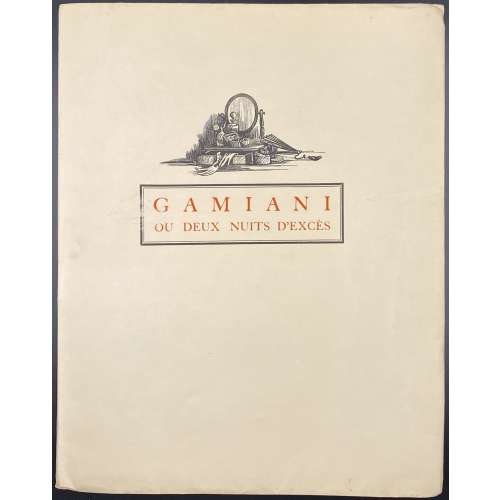 Description: Softcover volume 27 x 21.3 cm in publisher’s French flapped cream wrappers, with a vignette and lettered in red within a black frame to front "GAMIANI | OU DEUX NUITS D'EXCÈS". Printed on unmarked wove paper, outer and lower margins untrimmed. Illustrated with full-page frontispiece, 10 headpieces, and 5 smaller woodcuts (one repeated on the front wrapper and on t.p.) by Pierre Aubert after Jean-Gabriel Daragnès [pseud. Jean de Guethary], some with inlaid tissue guards. Copy enriched with one graphite pencil drawing signed "J. de Guethary", tipped in before h.t. Title-page (red and black): GAMIANI | OU DEUX NUITS D'EXCÈS | PAR A. DE M. | Avec | des vignettes | de | JEAN DE GUETHARY | {VIGNETTE} | — | CHEZ UN BOURGEOIS DE PARIS | Rue du Coq Hardi | 1845 || Pagination: [i-vi] (orig. drawing, h.t. / vignette, t.p./limit.) [vii] viii-xx, [1-3] 4-64 [4]; total 88 pages. Limitation: Edition limited to 110 copies. According to Dutel, 110 copies were printed on Japon ancient, 3 on Japon Impérial, and 3 on Whatman. This copy is № 115. Catalogue raisonné: Dutel (1920-1970): № 1630, p. 183; Pia (Enfer) 527, p. 286. Alfred de Musset (French, 1810 – 1857) – author. Jean-Gabriel Daragnès (French, 1886 – 1950) – artist, publisher. Pierre Aubert (Swiss, 1910 – 1987) – engraver.
Description: Softcover volume 27 x 21.3 cm in publisher’s French flapped cream wrappers, with a vignette and lettered in red within a black frame to front "GAMIANI | OU DEUX NUITS D'EXCÈS". Printed on unmarked wove paper, outer and lower margins untrimmed. Illustrated with full-page frontispiece, 10 headpieces, and 5 smaller woodcuts (one repeated on the front wrapper and on t.p.) by Pierre Aubert after Jean-Gabriel Daragnès [pseud. Jean de Guethary], some with inlaid tissue guards. Copy enriched with one graphite pencil drawing signed "J. de Guethary", tipped in before h.t. Title-page (red and black): GAMIANI | OU DEUX NUITS D'EXCÈS | PAR A. DE M. | Avec | des vignettes | de | JEAN DE GUETHARY | {VIGNETTE} | — | CHEZ UN BOURGEOIS DE PARIS | Rue du Coq Hardi | 1845 || Pagination: [i-vi] (orig. drawing, h.t. / vignette, t.p./limit.) [vii] viii-xx, [1-3] 4-64 [4]; total 88 pages. Limitation: Edition limited to 110 copies. According to Dutel, 110 copies were printed on Japon ancient, 3 on Japon Impérial, and 3 on Whatman. This copy is № 115. Catalogue raisonné: Dutel (1920-1970): № 1630, p. 183; Pia (Enfer) 527, p. 286. Alfred de Musset (French, 1810 – 1857) – author. Jean-Gabriel Daragnès (French, 1886 – 1950) – artist, publisher. Pierre Aubert (Swiss, 1910 – 1987) – engraver. -
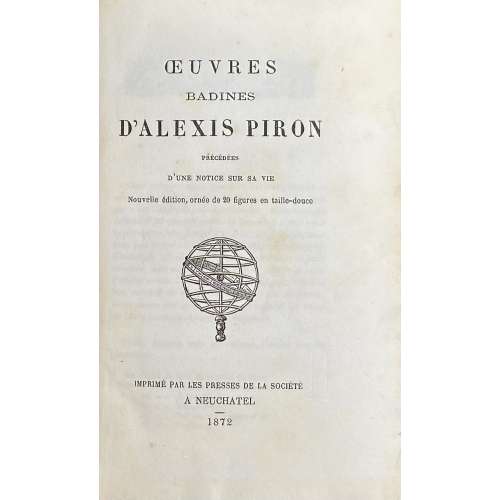 Single volume, 17.1 x 11.2 cm, quarter black sheepskin over faux chagrin, gilt lettering to spine, marbled endpapers, bottom and outer margin untrimmed, pp.: [i-v] vi- xxxvi, [1] 2-218 [2], collated 4to: π2, a-d4, 1-274 282, total 256 pages or 128 leaves, plus 20 engraved plates by Paul Sellier, including frontispiece portrait of Alexis Piron after bust by Caffieri. Vol. 8 of Bibliothèque Libre, Œuvres badines de Piron, printed on February 15, 1872. Text printed on dense wove paper watermarked P or M, plates printed on India wove paper. A reprint of an edition published in 1796 plus illustrations. Title-page: ŒUVRES | BADINES | D’ALEXIS PIRON | PRÉCÉDÉES | D’UNE NOTICE SUR SA VIE | Nouvelle édition, ornée de 20 figures en taille-douce | {vignette} | IMPRIMÉ PAR LES PRESSES DE LA SOCIÉTÉ | A NEUCHATEL | – | 1872 || Limitation: 100 numbered copies, of which this is № 75. Catalogue raisonné: Dutel I: A-788; Pia: 953-6; Kearney 377 (Patrick J. Kearney. A Catalogue of the publications of Jules Gay, Jean-Jules Gay & Gay et Doucé, revised & expanded. — Santa Rosa, CA Scissors & Paste Bibliographies, 2019) Catalogue Poulet-Malassis & ses amis description: № 81. Alexis PIRON. Œuvres badines précédées d’une notice sur sa vie. Nouvelle édition ornée de 20 figures en taille-douce. [ Jules Gay] Imprimé par les presses de la société, à Neufchatel, 1872. In-8, xxxvi, 218 pages et un feuillet d’achevé d’imprimer de table, demi-basane noire, dos à faux nerfs, tête et tranches naturelles. Illustré d’un portrait et de 20 figures par Paul Sellier. Tirage limité à 100 ex. numérotés. De la « Bibliothèque libre ou collection choisie d’ouvrages du genre libre, imprimés ou réimprimés par les soins de la Société des Bibliophiles Cosmopolites et pour les membres de cette société, à cent exemplaires numérotés ». Bibliographie : Pia 1030, Enfer 1274, Lem 3-454, Gay 5-339, PC 353, G* 38, Pey 203, Dutel A-788." Contributors: Alexis Piron (French, 1689 – 1773) – author. Paul Sellier (French, 1842 – 19..?) – artist. Jules Léopold Gay (French, 1807 – 1887) – publisher.
Single volume, 17.1 x 11.2 cm, quarter black sheepskin over faux chagrin, gilt lettering to spine, marbled endpapers, bottom and outer margin untrimmed, pp.: [i-v] vi- xxxvi, [1] 2-218 [2], collated 4to: π2, a-d4, 1-274 282, total 256 pages or 128 leaves, plus 20 engraved plates by Paul Sellier, including frontispiece portrait of Alexis Piron after bust by Caffieri. Vol. 8 of Bibliothèque Libre, Œuvres badines de Piron, printed on February 15, 1872. Text printed on dense wove paper watermarked P or M, plates printed on India wove paper. A reprint of an edition published in 1796 plus illustrations. Title-page: ŒUVRES | BADINES | D’ALEXIS PIRON | PRÉCÉDÉES | D’UNE NOTICE SUR SA VIE | Nouvelle édition, ornée de 20 figures en taille-douce | {vignette} | IMPRIMÉ PAR LES PRESSES DE LA SOCIÉTÉ | A NEUCHATEL | – | 1872 || Limitation: 100 numbered copies, of which this is № 75. Catalogue raisonné: Dutel I: A-788; Pia: 953-6; Kearney 377 (Patrick J. Kearney. A Catalogue of the publications of Jules Gay, Jean-Jules Gay & Gay et Doucé, revised & expanded. — Santa Rosa, CA Scissors & Paste Bibliographies, 2019) Catalogue Poulet-Malassis & ses amis description: № 81. Alexis PIRON. Œuvres badines précédées d’une notice sur sa vie. Nouvelle édition ornée de 20 figures en taille-douce. [ Jules Gay] Imprimé par les presses de la société, à Neufchatel, 1872. In-8, xxxvi, 218 pages et un feuillet d’achevé d’imprimer de table, demi-basane noire, dos à faux nerfs, tête et tranches naturelles. Illustré d’un portrait et de 20 figures par Paul Sellier. Tirage limité à 100 ex. numérotés. De la « Bibliothèque libre ou collection choisie d’ouvrages du genre libre, imprimés ou réimprimés par les soins de la Société des Bibliophiles Cosmopolites et pour les membres de cette société, à cent exemplaires numérotés ». Bibliographie : Pia 1030, Enfer 1274, Lem 3-454, Gay 5-339, PC 353, G* 38, Pey 203, Dutel A-788." Contributors: Alexis Piron (French, 1689 – 1773) – author. Paul Sellier (French, 1842 – 19..?) – artist. Jules Léopold Gay (French, 1807 – 1887) – publisher. -
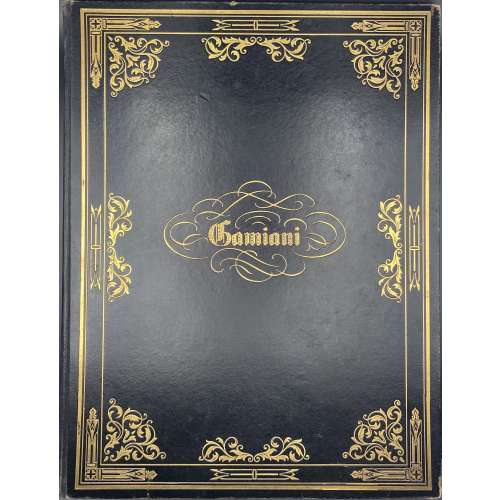 A German translation of de Musset’s “Gamiani ou deux nuits d’excès” illustrated with a reprint title-page and 11 (instead of 16) hand-coloured photogravures after original lithographs by Devéria and Henri Grévedon or Octave Tassaert for 1833 edition, though from the re-drawn stones. Large volume, 40.5 x 31 cm, collated 4to, in black calf with lettering and elaborate gilt border to front and blind border to back, outer and bottom margins uncut, marbled endpapers, text and plates printed on wove paper. The reprint t.p. is different from the original one; in the 1833 edition, the line deux nuits d’excès is waving while here it is straight. Letterpress title-page: ALFRED DE MUSSET | GAMIANI | ODER | ZWEI NÄCHTE DER AUSSCHWEIFUNG || Reprint title-page: Gamiani | OU | DEUX NUITS D’EXCÈS. | {vignette} | Bruxelles | 1833 || Collation: π2 1-74 82, total 32 leaves plus reprint t.p. and 11 plates. Pagination: [4] [1] 2-59 [60], total 64 pages, ils. Limitation: Edition limited to 300 numbered copies, of which this is copy № 32. Contributors: Alfred de Musset (French, 1810 – 1857) – author. Karl Spieler (German, 19th/20th century) – author of the foreword and translator. Achille Devéria (French, 1800 – 1857) – artist (attributed). Pierre Louis Henri Grévedon (French, 1776 – 1860) – artist (attributed). Octave Tassaert (French, 1800 – 1874) – artist (attributed). Catalogue raisonné: Dutel (1650-1880) № A-460, p. 149; Eros invaincu № 68, p. 171-3.
A German translation of de Musset’s “Gamiani ou deux nuits d’excès” illustrated with a reprint title-page and 11 (instead of 16) hand-coloured photogravures after original lithographs by Devéria and Henri Grévedon or Octave Tassaert for 1833 edition, though from the re-drawn stones. Large volume, 40.5 x 31 cm, collated 4to, in black calf with lettering and elaborate gilt border to front and blind border to back, outer and bottom margins uncut, marbled endpapers, text and plates printed on wove paper. The reprint t.p. is different from the original one; in the 1833 edition, the line deux nuits d’excès is waving while here it is straight. Letterpress title-page: ALFRED DE MUSSET | GAMIANI | ODER | ZWEI NÄCHTE DER AUSSCHWEIFUNG || Reprint title-page: Gamiani | OU | DEUX NUITS D’EXCÈS. | {vignette} | Bruxelles | 1833 || Collation: π2 1-74 82, total 32 leaves plus reprint t.p. and 11 plates. Pagination: [4] [1] 2-59 [60], total 64 pages, ils. Limitation: Edition limited to 300 numbered copies, of which this is copy № 32. Contributors: Alfred de Musset (French, 1810 – 1857) – author. Karl Spieler (German, 19th/20th century) – author of the foreword and translator. Achille Devéria (French, 1800 – 1857) – artist (attributed). Pierre Louis Henri Grévedon (French, 1776 – 1860) – artist (attributed). Octave Tassaert (French, 1800 – 1874) – artist (attributed). Catalogue raisonné: Dutel (1650-1880) № A-460, p. 149; Eros invaincu № 68, p. 171-3. -
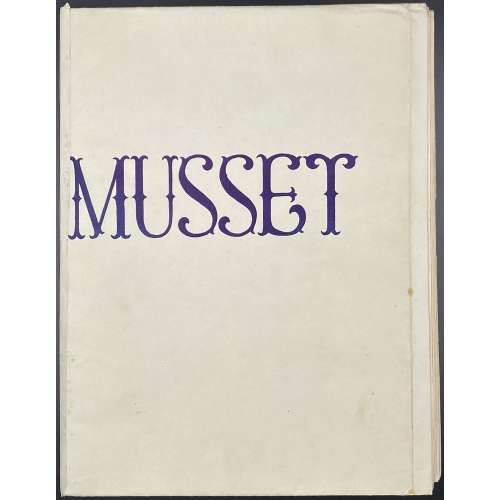 Description: one volume in French flapped wrappers 25.3 x 19 cm, lettered “MUSSET” to front, 5 gatherings of 4 and one of 6 leaves, 26 leaves total, pp.: [4] [2] 3-43 [44] [4], total 52 pages, incl. those in wrappers, unbound; plus coloured and uncoloured suites of 12 lithographs, in a paper folder; in a cardboard tan slipcase 2.8 x 19.3 cm. Artist unknown, publisher unknown, published at the end of 1940s (per J.-P. Dutel). Illustrations are a loose interpretation of original lithographs by Devéria and Henri Grévedon or Octave Tassaert for the 1833 edition ((1926 re-print LIB-3135.2023). Limitation: Edition limited to 250 copies printed on Vélin Chiffon numbered 1 -250 and 24 copies marked by letters A to Z. This is copy № 246, with two suites of plates, one coloured and one b/w. Catalogue raisonné: Dutel (1920-1970) № 1657, p. 189. Alfred de Musset (French, 1810 – 1857) – author.
Description: one volume in French flapped wrappers 25.3 x 19 cm, lettered “MUSSET” to front, 5 gatherings of 4 and one of 6 leaves, 26 leaves total, pp.: [4] [2] 3-43 [44] [4], total 52 pages, incl. those in wrappers, unbound; plus coloured and uncoloured suites of 12 lithographs, in a paper folder; in a cardboard tan slipcase 2.8 x 19.3 cm. Artist unknown, publisher unknown, published at the end of 1940s (per J.-P. Dutel). Illustrations are a loose interpretation of original lithographs by Devéria and Henri Grévedon or Octave Tassaert for the 1833 edition ((1926 re-print LIB-3135.2023). Limitation: Edition limited to 250 copies printed on Vélin Chiffon numbered 1 -250 and 24 copies marked by letters A to Z. This is copy № 246, with two suites of plates, one coloured and one b/w. Catalogue raisonné: Dutel (1920-1970) № 1657, p. 189. Alfred de Musset (French, 1810 – 1857) – author. -
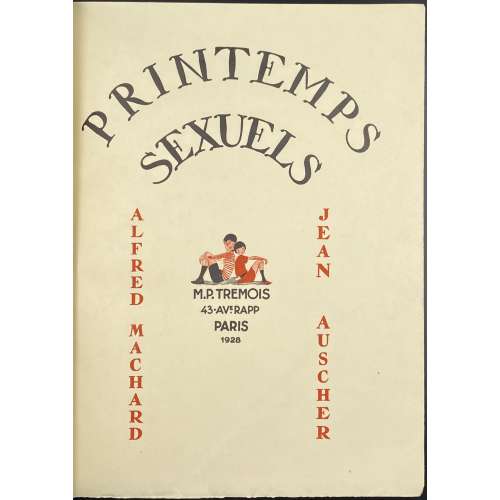 Description: One volume, 27 x 21 cm, collated 4to, bound in ¾ red morocco over marbled boards, raised bands, gilt in compartments, gilt lettering to spine, marbled endpapers, publisher’s wrappers and spine preserved, T.E.G. Title-page: ALFRED MACHARD | – | PRINTEMPS | SEXUELS… | L'EPOPEE AU FAUBOURG | Des anges ? Non. | Des petit d’hommes… | LITHOGRAPHIES DE | JEAN AUSCHER | PARIS | ÉDITIONS M.-P. TRÉMOIS | 43, AVENUE RAPP | – | 1928 || Collation: 1st blank, front wrapper, 3 blanks, π5 (h.t./limitation, t.p./copyright, dedication, Freud, Rimbaud), 1-214, 2 blanks, back wrapper, spine, last blank; total 94 leaves between the wrappers, and 10 plates extraneous to collation, incl. frontispiece – chromolithographs by Jean Auscher. Pagination: [6 blanks] [1-10] 11-175 [176] [2 colophon] [4 blanks], total 178 pages, ils. Limitation: Print run limited to 352 copies, one № 0 unique on Japon paper, enriched; one № 00 on Japon paper, enriched; 15 copies marked A-O on Japon paper, enriched; 35 copies on Hollande Van Gelder, enriched with one suite in black, № I-XXXV; 300 copies on vélin d’Arches, № 1-300, of which this copy is № 127. Colophon: Printed on April 20, 1928; text by Coulouma (Argenteuil), plates by Mourlot Frères (Paris). Contributors: Alfred Machard (French, 1887 – 1962) –author. Jean Auscher (French, 1896 – c. 1950) – artist.
Description: One volume, 27 x 21 cm, collated 4to, bound in ¾ red morocco over marbled boards, raised bands, gilt in compartments, gilt lettering to spine, marbled endpapers, publisher’s wrappers and spine preserved, T.E.G. Title-page: ALFRED MACHARD | – | PRINTEMPS | SEXUELS… | L'EPOPEE AU FAUBOURG | Des anges ? Non. | Des petit d’hommes… | LITHOGRAPHIES DE | JEAN AUSCHER | PARIS | ÉDITIONS M.-P. TRÉMOIS | 43, AVENUE RAPP | – | 1928 || Collation: 1st blank, front wrapper, 3 blanks, π5 (h.t./limitation, t.p./copyright, dedication, Freud, Rimbaud), 1-214, 2 blanks, back wrapper, spine, last blank; total 94 leaves between the wrappers, and 10 plates extraneous to collation, incl. frontispiece – chromolithographs by Jean Auscher. Pagination: [6 blanks] [1-10] 11-175 [176] [2 colophon] [4 blanks], total 178 pages, ils. Limitation: Print run limited to 352 copies, one № 0 unique on Japon paper, enriched; one № 00 on Japon paper, enriched; 15 copies marked A-O on Japon paper, enriched; 35 copies on Hollande Van Gelder, enriched with one suite in black, № I-XXXV; 300 copies on vélin d’Arches, № 1-300, of which this copy is № 127. Colophon: Printed on April 20, 1928; text by Coulouma (Argenteuil), plates by Mourlot Frères (Paris). Contributors: Alfred Machard (French, 1887 – 1962) –author. Jean Auscher (French, 1896 – c. 1950) – artist. -
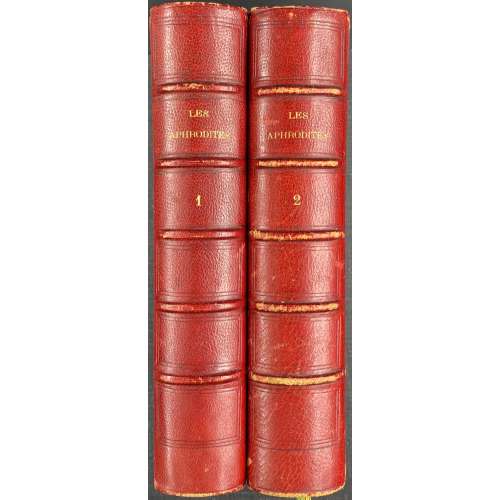 Two volumes in-12, 16.7 x 11.5 x 3.5 cm each, uniformly bound in quarter crimson morocco over marbled boards, spine with raised bands, gilt lettering, marbled endpapers, top margin gilt; text printed on laid paper, plates – on India paper: loose frontispiece by Félix Lukkow after Félicien Rops with tissue guard and 4 loose engraved plates by Félix Lukkow after Sigmund Freudenberger, in each volume. This edition is a reprint of an earlier publication: ANDRÉA DE NERCIAT, André-Robert (1739 - 1800). Les Aphrodites ou Fragments thali-priapiques pour servir à l'histoire du plaisir. Numéro Un et deux [Numéro trois et quatre [...] sept et huit]. 1793-1864. [Bruxelles : Briard pour Poulet-Malassis, 1864] with plated recarved by Félix Lukkow. Title-page: LES | APHRODITES | OU | FRAGMENTS THALI-PRIAPIQUES | POUR SERVIR A | L’HISTOIRE DU PLAISIR | — | Priape, soutiens mon hàleine… | Piron, Ode | — | Tome premier (second). | {publisher’s device} | A LAMPSAQUE | – | 1793 || Limitation: Edition is limited to 150 copies of which 130 on papier vergé, 5 on papier album jaune, 10 copies in-8o on large papier fort de Hollande, and one unique copy on peau de vélin. The number of this copy is left blank in both volumes. Vol. 1: π4 (h.t./limit., t.p./table, Éclaircissements historiques par V. M. D.), 1-2712 2910; total 182 leaves plus 5 leaves of plates, incl. frontispiece. Pagination: [1-5] 6-364, ils. V. M. D. stands for Vital Désiré Maximilien [Puissant]. Vol. 2: π2 (h.t., t.p.), 1-2912, 3110; total 192 leaves plus 5 leaves of plates, incl. frontispiece. Pagination: [1-5] 6-384, ils. Catalogue raisonné: Dutel I: A-95. Catalogue Poulet-Malassis & ses amis description: № 67. André-Robert ANDRÉA DE NERCIAT - [Félix LUKKOW]. Les Aphrodites, ou fragments thali-priapiques pour servir à l’histoire du plaisir. Tome premier (— second). A Lampsaque, 1793 [Vital Puissant, vers 1872]. 2 volumes in-12 de 364 et 384 pages, demi-maroquin rouge, dos à nerfs, tête dorée, non rogné (reliure de l’époque). Illustré de 2 frontispices et 8 planches volantes, par Félix Lukkow, d’après Félicien Rops pour les frontispices et Freundeberg pour les figures. Tirage limité à 151 ex. Contributors: André-Robert Andréa de Nerciat (French, 1739 – 1800) – author. Sigmund Freudenberger (Swiss, 1745 – 1801) – artist. Félicien Rops (Belgian, 1833 – 1898) – artist. Félix Lukkow (French, fl. c. 1870 – 1875) – engraver.
Two volumes in-12, 16.7 x 11.5 x 3.5 cm each, uniformly bound in quarter crimson morocco over marbled boards, spine with raised bands, gilt lettering, marbled endpapers, top margin gilt; text printed on laid paper, plates – on India paper: loose frontispiece by Félix Lukkow after Félicien Rops with tissue guard and 4 loose engraved plates by Félix Lukkow after Sigmund Freudenberger, in each volume. This edition is a reprint of an earlier publication: ANDRÉA DE NERCIAT, André-Robert (1739 - 1800). Les Aphrodites ou Fragments thali-priapiques pour servir à l'histoire du plaisir. Numéro Un et deux [Numéro trois et quatre [...] sept et huit]. 1793-1864. [Bruxelles : Briard pour Poulet-Malassis, 1864] with plated recarved by Félix Lukkow. Title-page: LES | APHRODITES | OU | FRAGMENTS THALI-PRIAPIQUES | POUR SERVIR A | L’HISTOIRE DU PLAISIR | — | Priape, soutiens mon hàleine… | Piron, Ode | — | Tome premier (second). | {publisher’s device} | A LAMPSAQUE | – | 1793 || Limitation: Edition is limited to 150 copies of which 130 on papier vergé, 5 on papier album jaune, 10 copies in-8o on large papier fort de Hollande, and one unique copy on peau de vélin. The number of this copy is left blank in both volumes. Vol. 1: π4 (h.t./limit., t.p./table, Éclaircissements historiques par V. M. D.), 1-2712 2910; total 182 leaves plus 5 leaves of plates, incl. frontispiece. Pagination: [1-5] 6-364, ils. V. M. D. stands for Vital Désiré Maximilien [Puissant]. Vol. 2: π2 (h.t., t.p.), 1-2912, 3110; total 192 leaves plus 5 leaves of plates, incl. frontispiece. Pagination: [1-5] 6-384, ils. Catalogue raisonné: Dutel I: A-95. Catalogue Poulet-Malassis & ses amis description: № 67. André-Robert ANDRÉA DE NERCIAT - [Félix LUKKOW]. Les Aphrodites, ou fragments thali-priapiques pour servir à l’histoire du plaisir. Tome premier (— second). A Lampsaque, 1793 [Vital Puissant, vers 1872]. 2 volumes in-12 de 364 et 384 pages, demi-maroquin rouge, dos à nerfs, tête dorée, non rogné (reliure de l’époque). Illustré de 2 frontispices et 8 planches volantes, par Félix Lukkow, d’après Félicien Rops pour les frontispices et Freundeberg pour les figures. Tirage limité à 151 ex. Contributors: André-Robert Andréa de Nerciat (French, 1739 – 1800) – author. Sigmund Freudenberger (Swiss, 1745 – 1801) – artist. Félicien Rops (Belgian, 1833 – 1898) – artist. Félix Lukkow (French, fl. c. 1870 – 1875) – engraver. -
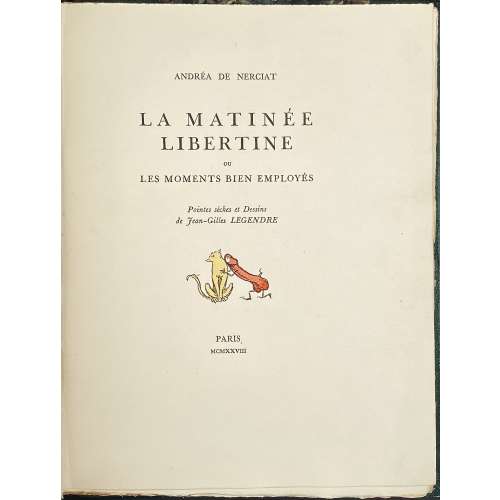 Front wrapper: LA MATINÉE | {vignette} | LIBERTINE || Title-page: ANDRÉA DE NERCIAT | LA MATINÉE | LIBERTINE | OU LES MOMENTS BIEN EMPLOYÉS | Pointes sèches et Dessins | de Jean-Gilles LEGENDRE | {fleuron in colour} | PARIS | MCMXXVIII || Description: Owner’s ¾ green morocco over marbled boards, raised bands, gilt lettering to spine, 24.3 x 19 cm overall, 23 x 17.5 cm leaves, green marbled endpapers, printed on BFK Rives watermarked wove paper. Collation: Orig. wrapper, [1-4] 2 blank leaves, [5-6] h.t. / limitation, [7-8] t.p. / blank, [9-10] avant-propos / blank, [11] 12-118, 4 blank leaves, orig. spine, orig. back wrapper, 9 hand-coloured dry-point plates with tissue guards, incl. engraved title/frontispiece, in-text colour illustrations (chromoxylography?). Limitation: A print run of 196 copies, № 1 on Vieux Japon, №№ 2-9 on Japon Impérial, №№ 10-21 on Hollande Van Gelder, and №№ 22-196 on Velin à la forme; this copy marked "H.C." (Horse Commerce") – not for sale (NFS), printed over the print run and reserved for the artist, other contributors, and their friends. Catalogue raisonné: Dutel (1920-1970): № 1939, p. 255: attributes publisher, and in-text illustration count; does not provide for H.C. copies in limitation. Contributors: André-Robert Andréa de Nerciat (French, 1739 – 1800) – author. Gaston Trilleau [pseud. Jean-Gilles Legendre] (French, 1874 – 1945) – illustrator. Maurice Henri Hector Duflou (French, 1885 – 1951) – publisher/printer.
Front wrapper: LA MATINÉE | {vignette} | LIBERTINE || Title-page: ANDRÉA DE NERCIAT | LA MATINÉE | LIBERTINE | OU LES MOMENTS BIEN EMPLOYÉS | Pointes sèches et Dessins | de Jean-Gilles LEGENDRE | {fleuron in colour} | PARIS | MCMXXVIII || Description: Owner’s ¾ green morocco over marbled boards, raised bands, gilt lettering to spine, 24.3 x 19 cm overall, 23 x 17.5 cm leaves, green marbled endpapers, printed on BFK Rives watermarked wove paper. Collation: Orig. wrapper, [1-4] 2 blank leaves, [5-6] h.t. / limitation, [7-8] t.p. / blank, [9-10] avant-propos / blank, [11] 12-118, 4 blank leaves, orig. spine, orig. back wrapper, 9 hand-coloured dry-point plates with tissue guards, incl. engraved title/frontispiece, in-text colour illustrations (chromoxylography?). Limitation: A print run of 196 copies, № 1 on Vieux Japon, №№ 2-9 on Japon Impérial, №№ 10-21 on Hollande Van Gelder, and №№ 22-196 on Velin à la forme; this copy marked "H.C." (Horse Commerce") – not for sale (NFS), printed over the print run and reserved for the artist, other contributors, and their friends. Catalogue raisonné: Dutel (1920-1970): № 1939, p. 255: attributes publisher, and in-text illustration count; does not provide for H.C. copies in limitation. Contributors: André-Robert Andréa de Nerciat (French, 1739 – 1800) – author. Gaston Trilleau [pseud. Jean-Gilles Legendre] (French, 1874 – 1945) – illustrator. Maurice Henri Hector Duflou (French, 1885 – 1951) – publisher/printer. -
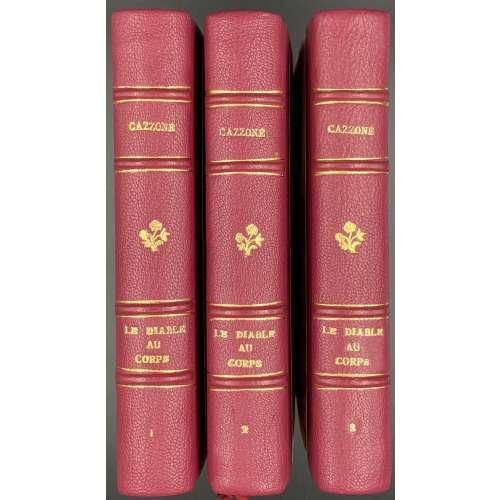 Description: Three volumes, 17 x 14 cm each, uniformly bound in quarter crimson morocco over marbled boards, spine with raised bands tooled gilt with gilt lettering and fleuron, marbled endpapers, publisher’s wrappers preserved (moire-waffle in light pink (vol. 1), cream (vol. 2) and blue (vol. 3), engraved), printed on wove paper, outer and bottom margin untrimmed, illustrated with etched/aquatint front wrapper, frontispiece, tail- and headpieces, and full-page plates in sepia, presumably after Zyg Brunner. Title-page (red and black): LE DIABLE | AU | CORPS | ŒUVRE POSTHUME | DU TRÈS RECOMMANDABLE DOCTEUR | CAZZONÉ | (ANDRÉA DE NERCIAT) | Membre extraordinaire de la joyeuse Faculté | phallo-coîro-pygo-glottonomique | TOME PREMIER (DEUXIÈME; TROISIÈME) | ALENÇON | 1930 || Vol. 1: front wrapper, blank leaf, h.t./limitation, t.p., [1] 2-180, 2 blank leaves, back wrapper; frontispiece, 7 full-page plates (incl. frontispiece), and 13 tail- and headpieces. Vol. 2: front wrapper, blank leaf, h.t./limitation, t.p., [1] 2-193 [194 blank], blank leaf, back wrapper; 8 full-page plates (incl. frontispiece), and 12 tail- and headpieces. Vol. 3: front wrapper, blank leaf, h.t./limitation, t.p., [1] 2-180 [181 colophon], [182 blank], blank leaf, back wrapper; frontispiece, 8 full-page plates (incl. frontispiece), and 13 tail- and headpieces. Limitation: 30 copies (№ 1-30) on Japon Impérial, 300 copies (№ 31-331) on Vélin d’Arches. This copy is № 109. Colophon: Printed on May 25, 1930, 350 copies on Vélin d’Arches with numbers from 31 to 380 [sic!] Catalogue raisonné: Dutel (1920-1970) № 1394, p. 129. Contributors: André-Robert Andréa de Nerciat (French, 1739 – 1800) – author. Zyg [Zygismund; Sigismond Leopold] Brunner (Polish, 1878 – 1961) – artist.
Description: Three volumes, 17 x 14 cm each, uniformly bound in quarter crimson morocco over marbled boards, spine with raised bands tooled gilt with gilt lettering and fleuron, marbled endpapers, publisher’s wrappers preserved (moire-waffle in light pink (vol. 1), cream (vol. 2) and blue (vol. 3), engraved), printed on wove paper, outer and bottom margin untrimmed, illustrated with etched/aquatint front wrapper, frontispiece, tail- and headpieces, and full-page plates in sepia, presumably after Zyg Brunner. Title-page (red and black): LE DIABLE | AU | CORPS | ŒUVRE POSTHUME | DU TRÈS RECOMMANDABLE DOCTEUR | CAZZONÉ | (ANDRÉA DE NERCIAT) | Membre extraordinaire de la joyeuse Faculté | phallo-coîro-pygo-glottonomique | TOME PREMIER (DEUXIÈME; TROISIÈME) | ALENÇON | 1930 || Vol. 1: front wrapper, blank leaf, h.t./limitation, t.p., [1] 2-180, 2 blank leaves, back wrapper; frontispiece, 7 full-page plates (incl. frontispiece), and 13 tail- and headpieces. Vol. 2: front wrapper, blank leaf, h.t./limitation, t.p., [1] 2-193 [194 blank], blank leaf, back wrapper; 8 full-page plates (incl. frontispiece), and 12 tail- and headpieces. Vol. 3: front wrapper, blank leaf, h.t./limitation, t.p., [1] 2-180 [181 colophon], [182 blank], blank leaf, back wrapper; frontispiece, 8 full-page plates (incl. frontispiece), and 13 tail- and headpieces. Limitation: 30 copies (№ 1-30) on Japon Impérial, 300 copies (№ 31-331) on Vélin d’Arches. This copy is № 109. Colophon: Printed on May 25, 1930, 350 copies on Vélin d’Arches with numbers from 31 to 380 [sic!] Catalogue raisonné: Dutel (1920-1970) № 1394, p. 129. Contributors: André-Robert Andréa de Nerciat (French, 1739 – 1800) – author. Zyg [Zygismund; Sigismond Leopold] Brunner (Polish, 1878 – 1961) – artist. -
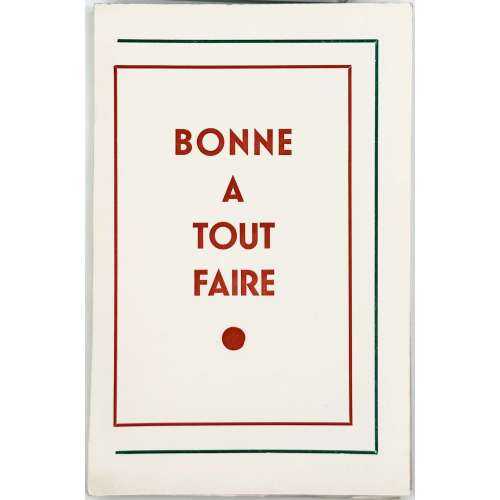 A softcover volume 18.7 x 12.1 cm, in publisher’s cream wrappers, red lettering in red and green frames to front cover, in glassine dustwrapper, uncut, untrimmed, collated in 8vo: 1-98 104, pp. [1-8] 9-151 [152 blank], plus 6 illustrations reproduced in drypoint after Mario Tauzin's lithographs from the album 'Interdit aux adultes' (see SVE-0547.2024). Front cover : BONNE | A | TOUT | FAIRE Title-page : BONNE | A | TOUT | FAIRE Stated limited edition of 900, strictly for subscribers. According to J.-P. Dutel III 1108 (p.66): published by Éric Losfeld in the late 1950s. Bonne à tout faire is a French idiom = maid-of-all-work Éric Losfeld (Belgian-French, 1922 – 1979) — publisher Mario Tauzin (French, 1909 – 1979) — artist
A softcover volume 18.7 x 12.1 cm, in publisher’s cream wrappers, red lettering in red and green frames to front cover, in glassine dustwrapper, uncut, untrimmed, collated in 8vo: 1-98 104, pp. [1-8] 9-151 [152 blank], plus 6 illustrations reproduced in drypoint after Mario Tauzin's lithographs from the album 'Interdit aux adultes' (see SVE-0547.2024). Front cover : BONNE | A | TOUT | FAIRE Title-page : BONNE | A | TOUT | FAIRE Stated limited edition of 900, strictly for subscribers. According to J.-P. Dutel III 1108 (p.66): published by Éric Losfeld in the late 1950s. Bonne à tout faire is a French idiom = maid-of-all-work Éric Losfeld (Belgian-French, 1922 – 1979) — publisher Mario Tauzin (French, 1909 – 1979) — artist -
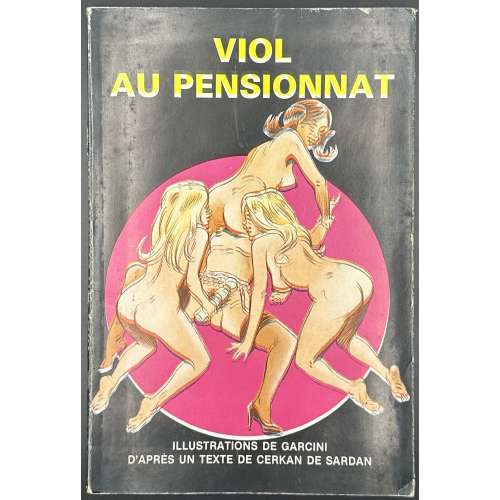 NEWSoftcover, French flapped pictorial wrappers, 240 x 160 mm, translated title: Rape at the boarding school, pp. [1-6] 7-164 [4], 40 black and white illustrations by Garcini. Title-page: D’après un texte de | CERKAN DE SARDAN | VIOL | AU PENSIONNAT | illustrations de | GARCINI ||
NEWSoftcover, French flapped pictorial wrappers, 240 x 160 mm, translated title: Rape at the boarding school, pp. [1-6] 7-164 [4], 40 black and white illustrations by Garcini. Title-page: D’après un texte de | CERKAN DE SARDAN | VIOL | AU PENSIONNAT | illustrations de | GARCINI || -
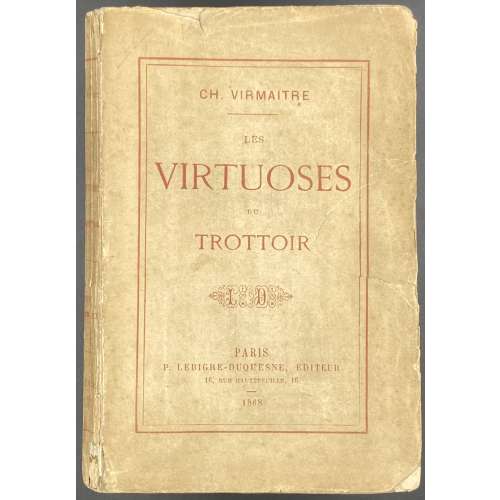 Cover: Ch. Virmaitre | LES | VIRTUOSES | DU | TROTTOIR | {publisher’s device} | PARIS | P. LEBIGRE-DUQUESNE, ÉDITEUR | 16, RUE HAUTEFEUILLE, 16 | 1868 || Title: Similar. Imprint: De Rouge Frères, Dunon et Fresné (Paris). Pagination: [1-7] 8-161 [162], [2] – table, [2] – advert., [14]; 90 leaves total; publisher’s cream wrappers with red lettering in double frame. Collation: 12mo in 6th; [1]-136, 1412. Charles Virmaître (French, 1835 – 1903).
Cover: Ch. Virmaitre | LES | VIRTUOSES | DU | TROTTOIR | {publisher’s device} | PARIS | P. LEBIGRE-DUQUESNE, ÉDITEUR | 16, RUE HAUTEFEUILLE, 16 | 1868 || Title: Similar. Imprint: De Rouge Frères, Dunon et Fresné (Paris). Pagination: [1-7] 8-161 [162], [2] – table, [2] – advert., [14]; 90 leaves total; publisher’s cream wrappers with red lettering in double frame. Collation: 12mo in 6th; [1]-136, 1412. Charles Virmaître (French, 1835 – 1903). -
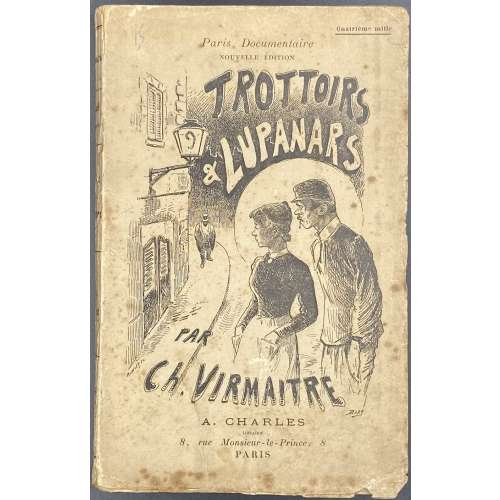 Front wrapper: Quatrième mille | Paris Documentaire | NOUVELLE ÉDITION | TROTTOIRS | ET | LUPANARS | PAR | Ch. VIRMAITRE | A. CHARLES | LIBRAIRE | 8, Rue Monsieur-le-Prince, 8 | PARIS || Title page: Ch. VIRMAITRE | PARIS DOCUMENTAIRE | (Mœurs) | TROTTOIRS | ET | LUPANARS | {fleuron} | A. CHARLES | LIBRAIRE | 8, Rue Monsieur-le-Prince, 8 | PARIS | 1897 || Collation: 18mo; Front pictorial wrapper, 2 ffls, π4, 118, 318, 518, 718, 918, 1118, 1318, 1514, back pictorial wrapper (portrait) Pagination: [1-7] 8-282 [6]. Binding: Publisher’s pictorial wrappers, lettering to spine. Charles Virmaître (French, 1835 – 1903).
Front wrapper: Quatrième mille | Paris Documentaire | NOUVELLE ÉDITION | TROTTOIRS | ET | LUPANARS | PAR | Ch. VIRMAITRE | A. CHARLES | LIBRAIRE | 8, Rue Monsieur-le-Prince, 8 | PARIS || Title page: Ch. VIRMAITRE | PARIS DOCUMENTAIRE | (Mœurs) | TROTTOIRS | ET | LUPANARS | {fleuron} | A. CHARLES | LIBRAIRE | 8, Rue Monsieur-le-Prince, 8 | PARIS | 1897 || Collation: 18mo; Front pictorial wrapper, 2 ffls, π4, 118, 318, 518, 718, 918, 1118, 1318, 1514, back pictorial wrapper (portrait) Pagination: [1-7] 8-282 [6]. Binding: Publisher’s pictorial wrappers, lettering to spine. Charles Virmaître (French, 1835 – 1903). -
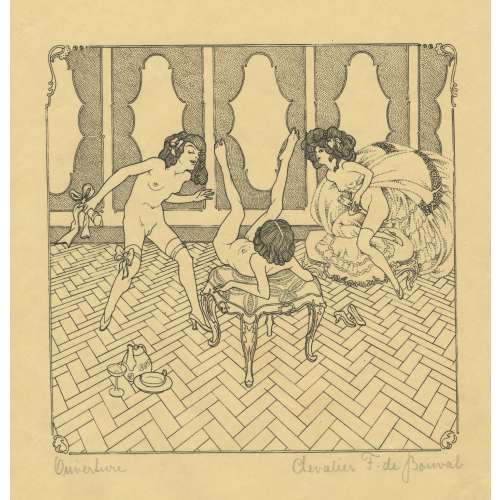 A set of sixteen planographic prints, signed and titled in pencil by owner “Chevalier F. de Bouval” (pseudonym of Franz von Bayros (Austrian, 1866 – 1924). Titles include: 1) Ouverture, 2) champagne brut, 3) maternité, 4) piano, 5) crudité délicieuse, 6. la belle vue, 7) au pensionnat, 8) le collier, 9) languelles pénètrelles, 10) introduction, 11) le sourrogat, 12) variation amoureuse, 13) la surprise, 14) le clef délicat, 15) le monstre gomme, 16) fruits de sud. Printed on wove paper, possibly engraved on wood after ink drawings by Franz von Bayros (Austrian, 1866 – 1924) under the pseudonym Chevalier F. de Bouval. Size: sheet 30 x 24 cm, image 18 x 17.5 cm. In another source, there are two more images from the same set: le passe-partout and la doublette, making 18 images altogether; the set is titled “Lesbia: XVIII sujets”, signed by Chevalier François René de Bouval.
A set of sixteen planographic prints, signed and titled in pencil by owner “Chevalier F. de Bouval” (pseudonym of Franz von Bayros (Austrian, 1866 – 1924). Titles include: 1) Ouverture, 2) champagne brut, 3) maternité, 4) piano, 5) crudité délicieuse, 6. la belle vue, 7) au pensionnat, 8) le collier, 9) languelles pénètrelles, 10) introduction, 11) le sourrogat, 12) variation amoureuse, 13) la surprise, 14) le clef délicat, 15) le monstre gomme, 16) fruits de sud. Printed on wove paper, possibly engraved on wood after ink drawings by Franz von Bayros (Austrian, 1866 – 1924) under the pseudonym Chevalier F. de Bouval. Size: sheet 30 x 24 cm, image 18 x 17.5 cm. In another source, there are two more images from the same set: le passe-partout and la doublette, making 18 images altogether; the set is titled “Lesbia: XVIII sujets”, signed by Chevalier François René de Bouval. -
 Woodblock print album of thirteen prints, ōban, nishiki-e. Artist: Chōkyōsai Eiri [鳥橋斎 栄里] (Japanese, fl. c. 1789 ~ 1801 ). Models of calligraphy (Fumi no kiyogaki), New Year 1801. This title is taken from Chris Uhlenbeck's Japanese Erotic Fantasies Sexual Imagery of the Edo Period. — Hotei Publishing, 2005, ISBN 90-74822-66-5):. A detailed description of the album can be found at The Complete Ukiyo-e Shunga №9 Eiri, 1996, ISBN 4-309-91019. Most of the edition is in Japanese, though Richard Lane writes a section in English: Eiri: Love-letters, Love Consummated: Fumi-no-kiyogaki. The article starts with the following statement: "Why all the fuss about Sharaku? Because he is so "mysterious"? No, not at all: because he is such a good artist. But Sharaku is not the only great yet enigmatic ukiyo-e artist and I propose to resurrect here one of his important contemporaries who has been all too long neglected: Chōkyōsai Eiri. As with many of the notable ukiyo-e masters, nothing is known of Eiri's biography. All we can say is what we learn from his extant prints and paintings: that he flourished during the second half of the Kansei Period [1789-1801]; and that he was a direct pupil of the great Eishi - who, being of eminent samurai stock, may well have attracted pupils of similar background." Another citation from Japanese Erotic Fantasies: "This album is one of the boldest sets of ōban-size shunga known, The first edition contains thirteen instead of the customary twelve designs". Here I present all thirteen prints, though the edition I bought in Kyoto in 2014 contained only twelve. The thirteenth print was purchased later in the United States (sheet №12).
Woodblock print album of thirteen prints, ōban, nishiki-e. Artist: Chōkyōsai Eiri [鳥橋斎 栄里] (Japanese, fl. c. 1789 ~ 1801 ). Models of calligraphy (Fumi no kiyogaki), New Year 1801. This title is taken from Chris Uhlenbeck's Japanese Erotic Fantasies Sexual Imagery of the Edo Period. — Hotei Publishing, 2005, ISBN 90-74822-66-5):. A detailed description of the album can be found at The Complete Ukiyo-e Shunga №9 Eiri, 1996, ISBN 4-309-91019. Most of the edition is in Japanese, though Richard Lane writes a section in English: Eiri: Love-letters, Love Consummated: Fumi-no-kiyogaki. The article starts with the following statement: "Why all the fuss about Sharaku? Because he is so "mysterious"? No, not at all: because he is such a good artist. But Sharaku is not the only great yet enigmatic ukiyo-e artist and I propose to resurrect here one of his important contemporaries who has been all too long neglected: Chōkyōsai Eiri. As with many of the notable ukiyo-e masters, nothing is known of Eiri's biography. All we can say is what we learn from his extant prints and paintings: that he flourished during the second half of the Kansei Period [1789-1801]; and that he was a direct pupil of the great Eishi - who, being of eminent samurai stock, may well have attracted pupils of similar background." Another citation from Japanese Erotic Fantasies: "This album is one of the boldest sets of ōban-size shunga known, The first edition contains thirteen instead of the customary twelve designs". Here I present all thirteen prints, though the edition I bought in Kyoto in 2014 contained only twelve. The thirteenth print was purchased later in the United States (sheet №12). №1: "...one of the most exotic scenes in all shunga. A Dutch kapitan is discovered coupling with a lovely Japanese courtesan, beside a large window opening upon a garden...".
№1: "...one of the most exotic scenes in all shunga. A Dutch kapitan is discovered coupling with a lovely Japanese courtesan, beside a large window opening upon a garden...".

 №2: "...a fair young harlot is seen masturbating with a grinding-pestle - a man watches intently from under bedding." [I have two specimens of this design; the one from album is more soiled but less faded].
№2: "...a fair young harlot is seen masturbating with a grinding-pestle - a man watches intently from under bedding." [I have two specimens of this design; the one from album is more soiled but less faded].
 №3: "...the artist has effectively contrasted the lovers by depicting the man's face as seen through the geisha's gauze skirt. [...] we are impressed more by strikingly elegant composition, the dramatic coloring, rather than feeling any great urge to participate in the energetic proceedings..."
№3: "...the artist has effectively contrasted the lovers by depicting the man's face as seen through the geisha's gauze skirt. [...] we are impressed more by strikingly elegant composition, the dramatic coloring, rather than feeling any great urge to participate in the energetic proceedings..."
 №4: "This scene is a most straightforward one, featuring the standard Missionary Position [capitalization by R. Lane].; but withal, the contrast of the young and naked, secret lover and the richly-clothed courtesan amid luxurious bedding..."
№4: "This scene is a most straightforward one, featuring the standard Missionary Position [capitalization by R. Lane].; but withal, the contrast of the young and naked, secret lover and the richly-clothed courtesan amid luxurious bedding..."
 №5: "In a striking lesbian scene (which has no equivalent in Utamaro, and is, incidentally, often omitted in later editions of this album), the girl at left prepares to receive the harikata (dildo) worn by the older girl at right (who holds a seashell containing lubricant)."
№5: "In a striking lesbian scene (which has no equivalent in Utamaro, and is, incidentally, often omitted in later editions of this album), the girl at left prepares to receive the harikata (dildo) worn by the older girl at right (who holds a seashell containing lubricant)."
 №6: "In the first appearance of a matronly heroine in this series, we find a widow - with shaven eyebrows and clipped hair - sporting with a handsome yound shop-clerk, mounting him with all her might."
№6: "In the first appearance of a matronly heroine in this series, we find a widow - with shaven eyebrows and clipped hair - sporting with a handsome yound shop-clerk, mounting him with all her might."

 №7: "... lady of samurai court: here, shown taking advantage of an official outing to temple and theatre, to rendezvous with a secret lover on a teahouse balcony." R. Lane considers this design the least successful in the series, especially in comparison with the same theme by Utamaro: "Utamaro female is almost ferocious in her lust for sexual gratification", which does not sound true to me. See Utamaro's sheet №5 from the album Utamakura (歌まくら, Poem of the Pillow) [courtesy The British Museum without permission]:
№7: "... lady of samurai court: here, shown taking advantage of an official outing to temple and theatre, to rendezvous with a secret lover on a teahouse balcony." R. Lane considers this design the least successful in the series, especially in comparison with the same theme by Utamaro: "Utamaro female is almost ferocious in her lust for sexual gratification", which does not sound true to me. See Utamaro's sheet №5 from the album Utamakura (歌まくら, Poem of the Pillow) [courtesy The British Museum without permission]:
 Then, as Richard Lane states, "we are flung suddenly to the bottom rung of Edo society":
Then, as Richard Lane states, "we are flung suddenly to the bottom rung of Edo society":
 №8: "Here we find a fair yotaka ('night-hawk', e.i. streetwalker) accommodating a lusty client in a lumberyard by the bank of the Sumida River".
№8: "Here we find a fair yotaka ('night-hawk', e.i. streetwalker) accommodating a lusty client in a lumberyard by the bank of the Sumida River".
 №9: '... a slightly plump harlot of the lower class receives a night visit from her lover, whose naked form she tries to cover with a cloak."
№9: '... a slightly plump harlot of the lower class receives a night visit from her lover, whose naked form she tries to cover with a cloak."
 №10: "...likely maidservant and lackey - are depicted in bath-room, their passions are all too obviously fired by steaming water."
№10: "...likely maidservant and lackey - are depicted in bath-room, their passions are all too obviously fired by steaming water."
 №11: "...this scene of courtesan and secret lover ranks high not only in Eiri's œuvre but also in the annals of the ukiyo-e genre itself. Both design and colouring are impeccable and, for this period, there is nothing even in the work of great Utamaro that really surpasses it." Again, a doubtful statement, however, this is Utamaro's design for the reader to judge:
№11: "...this scene of courtesan and secret lover ranks high not only in Eiri's œuvre but also in the annals of the ukiyo-e genre itself. Both design and colouring are impeccable and, for this period, there is nothing even in the work of great Utamaro that really surpasses it." Again, a doubtful statement, however, this is Utamaro's design for the reader to judge:
 The last design in my album is this:
The last design in my album is this:
 #13: In most reference books it goes under number 13, and we will assign this number to the sheet. "The final scene of the album features naked participants, probably samurai man and wife. The print is rather subdued in tone and colour, if not in the degree of the passion displayed..."
An additional sheet, acquired separately from a reputable dealer in New York, is usually listed as №12:
#13: In most reference books it goes under number 13, and we will assign this number to the sheet. "The final scene of the album features naked participants, probably samurai man and wife. The print is rather subdued in tone and colour, if not in the degree of the passion displayed..."
An additional sheet, acquired separately from a reputable dealer in New York, is usually listed as №12:
 №12: "One might think that Eiri has reached his peak with the preceding plate 11 - and indeed he has, in both esthetic and erotic terms. But the album is not yet finished, and the next scene lends a needed variety to the series, a slightly comic tableau featuring a middle-aged lackey attempting to forcibly seduce a servant girl of the same domicile". Utamaro's design, that inspired Eiri is here:
№12: "One might think that Eiri has reached his peak with the preceding plate 11 - and indeed he has, in both esthetic and erotic terms. But the album is not yet finished, and the next scene lends a needed variety to the series, a slightly comic tableau featuring a middle-aged lackey attempting to forcibly seduce a servant girl of the same domicile". Utamaro's design, that inspired Eiri is here:
 All descriptions are taken from Richard Lane's article at The Complete Ukiyo-e Shunga №9 Eiri, 1996. He concluded: "...Eiri's erotic series represents a major contribution to shunga art towards the close of ukiyo-e "Golden Age". In part inspired by Utamaro's classic album, this series withal constitutes a unified and original achievement, providing a cumulative effect of gracefully elegant yet glowing eroticism, which remains in the mind's eye long after the pictures themselves are far away."
I only would like to mention here that in several reference sources this album goes under name of Eisho; unfortunately, this mistake is reproduced at www.ukiyo-e.org, which miraculously shows exactly my print, but under the wrong name of the artist. The same mistake can be found at Shunga. The art of love in Japan. Tom and Mary Anne Evans. Paddington Press Ltd., 1975. ISBN 0-8467-0066-2; plates 6.74-6.77: Chōkyōsai Eishō, c. 1800. Even the British Museum edition of 2010 gives the same erroneous attribution: Chōkyōsai Eishō (1793-1801); they provide the following translation of title: "Clean Draft of a Letter" [see: Shunga. Erotic art in Japan. Rosina Buckland. The British Museum Press, 2010; pp. 110-112]. To the honour of the British Museum, I must admit that they have corrected themselves in Shunga. Sex and pleasure in Japanese art. Edited by Timothy Clark, et al. Hotei Publishing, 2013. Now, they say Chōkyōsai Eiri (worked c. 1790s-1801); they also provide a new title: "Neat Version of the Love Letter, or Pure Drawings of Female Beauty". I have already mentioned Richard Lane's version of title: "Love-letters, Love Consummated", and Chris Uhlenbeck's "Models of calligraphy". In poorly designed and printed Shunga. Erotic figures in Japanese art. Presented by Gabriele Mandel. Translated by Alison L'Eplattenier. Crescent Books, New York, 1983, the artist is named Shokyosai Eisho (beginning of the 19th century); title provided: "Models of Calligraphy". Correct attribution to Chōkyōsai Eiri also can be found at Poem of the pillow and other stories by Utamaro, Hokusai, Kuniyoshi and other artists of the floating world. Gian Carlo Calza in collaboration with Stefania Piotti. Phaidon Press, 2010; though the title is translated as "Clean Copy of Female Beauty".
All descriptions are taken from Richard Lane's article at The Complete Ukiyo-e Shunga №9 Eiri, 1996. He concluded: "...Eiri's erotic series represents a major contribution to shunga art towards the close of ukiyo-e "Golden Age". In part inspired by Utamaro's classic album, this series withal constitutes a unified and original achievement, providing a cumulative effect of gracefully elegant yet glowing eroticism, which remains in the mind's eye long after the pictures themselves are far away."
I only would like to mention here that in several reference sources this album goes under name of Eisho; unfortunately, this mistake is reproduced at www.ukiyo-e.org, which miraculously shows exactly my print, but under the wrong name of the artist. The same mistake can be found at Shunga. The art of love in Japan. Tom and Mary Anne Evans. Paddington Press Ltd., 1975. ISBN 0-8467-0066-2; plates 6.74-6.77: Chōkyōsai Eishō, c. 1800. Even the British Museum edition of 2010 gives the same erroneous attribution: Chōkyōsai Eishō (1793-1801); they provide the following translation of title: "Clean Draft of a Letter" [see: Shunga. Erotic art in Japan. Rosina Buckland. The British Museum Press, 2010; pp. 110-112]. To the honour of the British Museum, I must admit that they have corrected themselves in Shunga. Sex and pleasure in Japanese art. Edited by Timothy Clark, et al. Hotei Publishing, 2013. Now, they say Chōkyōsai Eiri (worked c. 1790s-1801); they also provide a new title: "Neat Version of the Love Letter, or Pure Drawings of Female Beauty". I have already mentioned Richard Lane's version of title: "Love-letters, Love Consummated", and Chris Uhlenbeck's "Models of calligraphy". In poorly designed and printed Shunga. Erotic figures in Japanese art. Presented by Gabriele Mandel. Translated by Alison L'Eplattenier. Crescent Books, New York, 1983, the artist is named Shokyosai Eisho (beginning of the 19th century); title provided: "Models of Calligraphy". Correct attribution to Chōkyōsai Eiri also can be found at Poem of the pillow and other stories by Utamaro, Hokusai, Kuniyoshi and other artists of the floating world. Gian Carlo Calza in collaboration with Stefania Piotti. Phaidon Press, 2010; though the title is translated as "Clean Copy of Female Beauty".
-
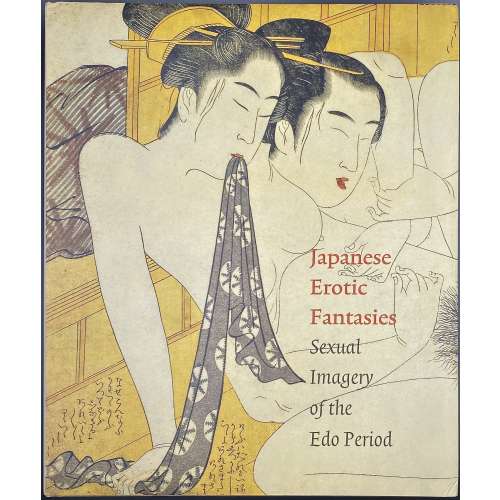 Hardcover volume, 30 x 25.5 cm, in brown cloth with yellow lettering to front cover and spine, in pictorial dust jacket, profusely illustrated in colour; pp.: [1-5] 6-256, total 128 leaves. Title-page (red and black): Japanese | Erotic | Fantasies | Sexual | Imagery | of the | Edo Period | Chris Uhlenbeck and | Margarita Winkel | with contributions by | Ellis Tinios | Cecilia Segawa Seigle | Oikawa Shigeru | Editor Amy Reigle Newland | {publisher’s device} Hotei Publishing, Amsterdam || Contents: Preface by Chris Uhlenbeck; Acknowledgements by Chris Uhlenbeck & Margarita Winkel; Editorial Notes; Shunga: the Issues by Chris Uhlenbeck; The Setting for shunga: the Yoshiwara by Cecilia Segawa Seigle; Erotic Books in the Floating World of Urban Life by Margarita Winkel; The Catalogue ('The Primitives'; The Age of Harunobu, Kiyonaga and Utamaro; The Nineteenth Century; The Meiji Period and Beyond); Appendix: Japanese characters for book, print and series titles; Glossary; Bibliography; General Index; Artists' Index. This publication coincides with the Exhibition "Desire of Spring. Erotic Fantasies in Edo Japan" from 22 January to 17 April 2005 in the Kunsthal Rotterdam (Impressum). Literaturverzeichnis: Seiten 247-250. Contributors: Chris Uhlenbeck Margarita Winkel Ellis Tinios Cecilia Segawa Seigle Oikawa Shigeru Amy Reigle Newland In this collection:
Hardcover volume, 30 x 25.5 cm, in brown cloth with yellow lettering to front cover and spine, in pictorial dust jacket, profusely illustrated in colour; pp.: [1-5] 6-256, total 128 leaves. Title-page (red and black): Japanese | Erotic | Fantasies | Sexual | Imagery | of the | Edo Period | Chris Uhlenbeck and | Margarita Winkel | with contributions by | Ellis Tinios | Cecilia Segawa Seigle | Oikawa Shigeru | Editor Amy Reigle Newland | {publisher’s device} Hotei Publishing, Amsterdam || Contents: Preface by Chris Uhlenbeck; Acknowledgements by Chris Uhlenbeck & Margarita Winkel; Editorial Notes; Shunga: the Issues by Chris Uhlenbeck; The Setting for shunga: the Yoshiwara by Cecilia Segawa Seigle; Erotic Books in the Floating World of Urban Life by Margarita Winkel; The Catalogue ('The Primitives'; The Age of Harunobu, Kiyonaga and Utamaro; The Nineteenth Century; The Meiji Period and Beyond); Appendix: Japanese characters for book, print and series titles; Glossary; Bibliography; General Index; Artists' Index. This publication coincides with the Exhibition "Desire of Spring. Erotic Fantasies in Edo Japan" from 22 January to 17 April 2005 in the Kunsthal Rotterdam (Impressum). Literaturverzeichnis: Seiten 247-250. Contributors: Chris Uhlenbeck Margarita Winkel Ellis Tinios Cecilia Segawa Seigle Oikawa Shigeru Amy Reigle Newland In this collection: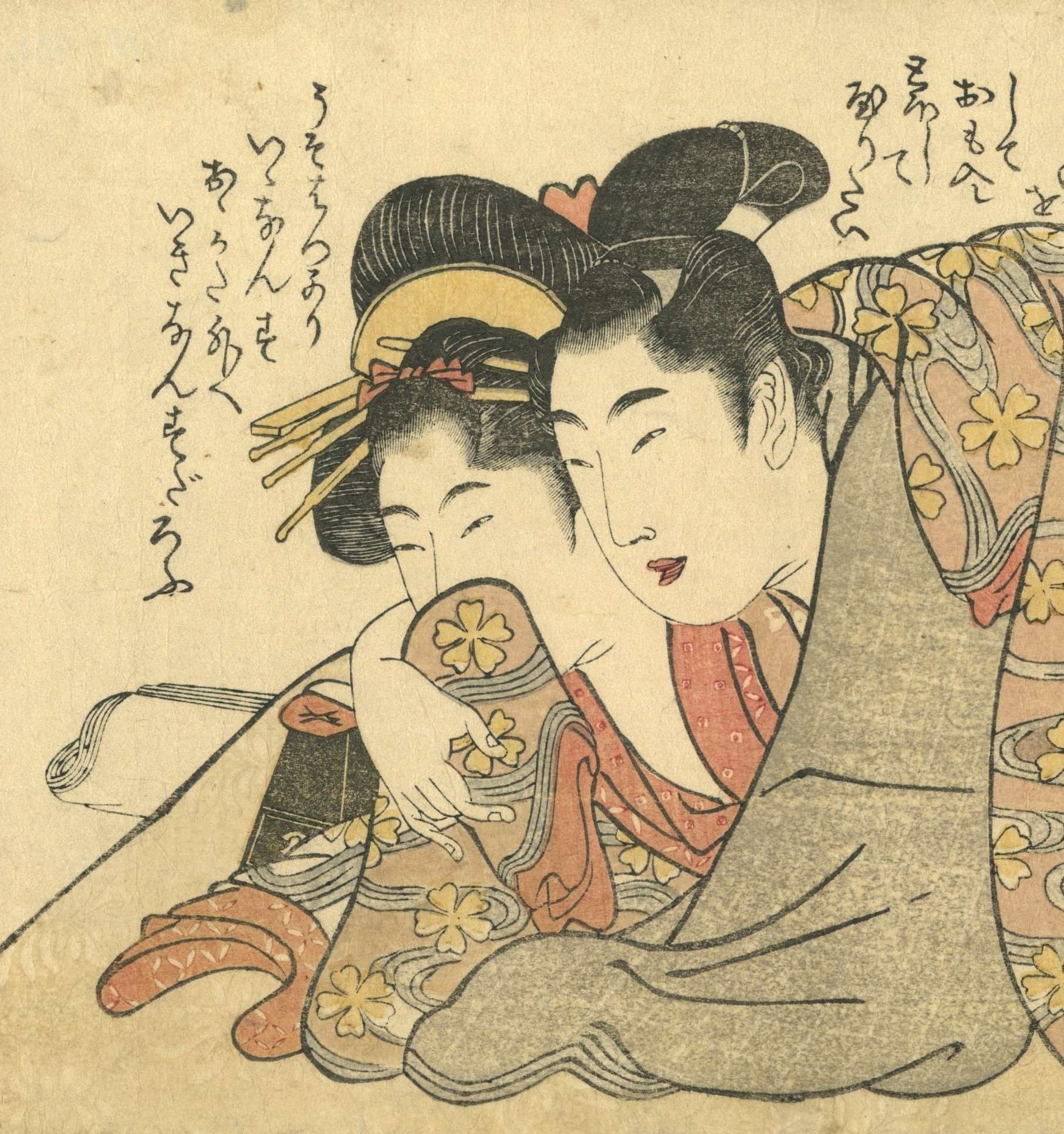
SVJP-0188.2015: Kitagawa Utamaro. Series of horizontal o-hosoban shunga prints, c. 1803.
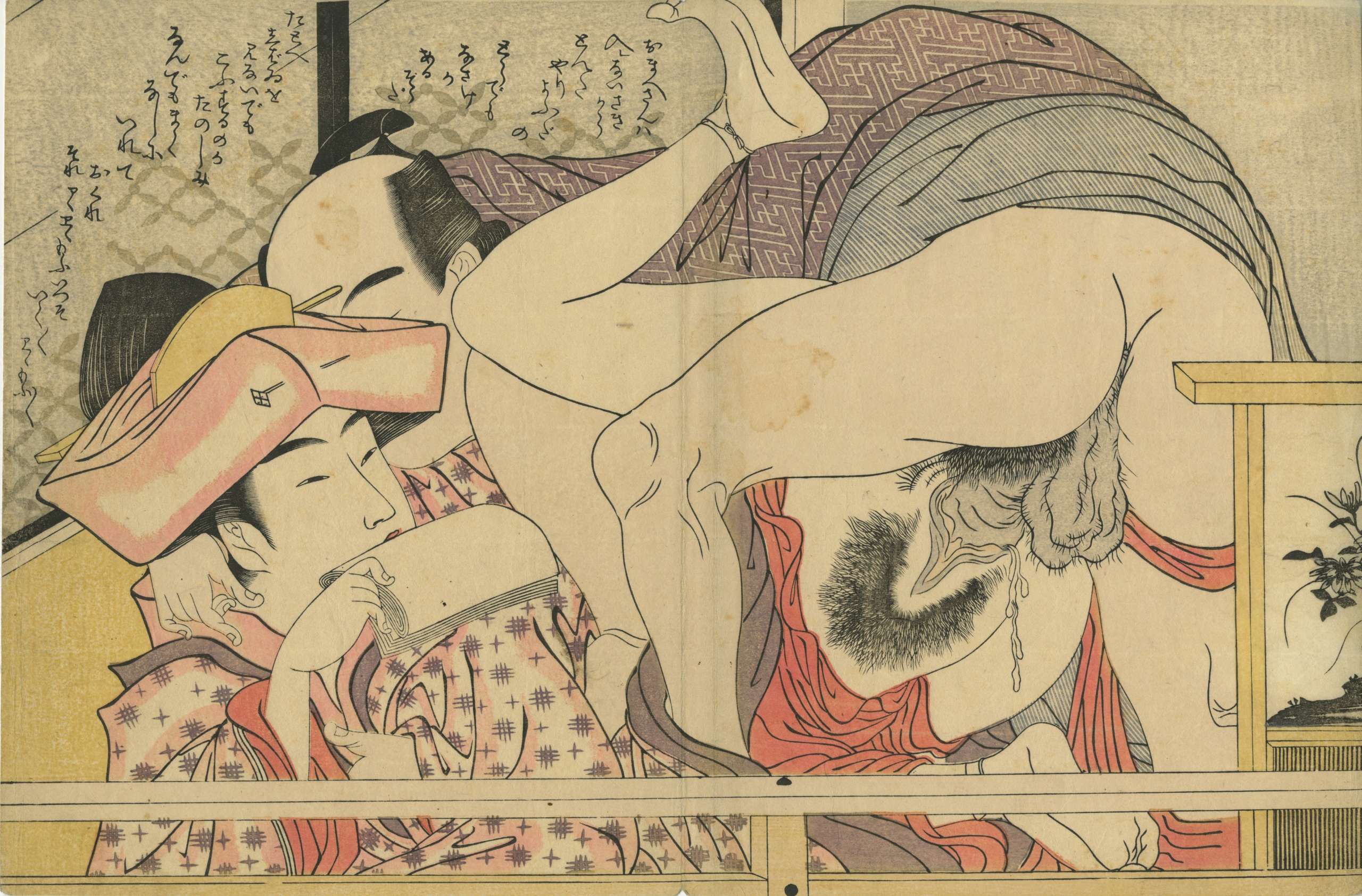
SVJP-0034.2014: Chōkyōsai Eiri. Neat version of a love letter (Fumi no kiyogaki), 1801.

SVJP-0041.2013: Torii Kiyonaga. Handscroll for the sleeve (Sode no maki), c. 1785.
-
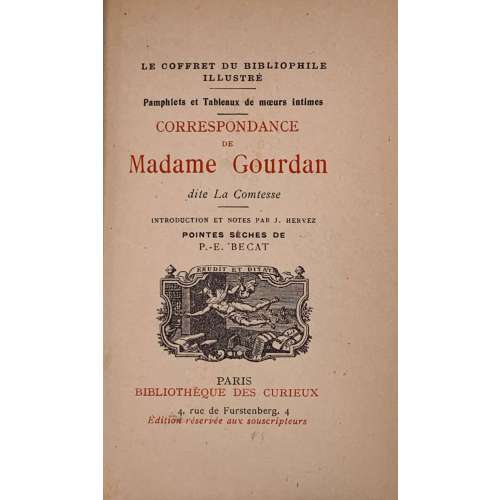 Front wrapper and title-page (in red and black): LE COFFRET DU BIBLIOPHILE ILLUSTRE | Pamphlets et Tableaux de mœurs intimes | CORRESPONDANCE | DE | Madame Gourdan | dite La Comtesse | INTRODUCTION ET NOTES PAR J. HERVEZ. | POINTES SÈCHES DE | P.-E. BECAT | {device} | PARIS | BIBLIOTHÈQUE DES CURIEUX | 4, rue de Furstenberg, 4 | Édition réservée aux souscripteurs || Limitation: L'édition illustrée du "Coffret | du bibliophile" est tirée à 750 | exemplaires, sur vergé de Rives, | – numérotés de 1 à 750 – | № 353 || Limited edition of 750 copies on Rives laid paper, of which this is copy № 353. Collation: fep, 3 blanks, front wrapper, 3 blanks vergé, [2] h.t. / limit., [2] t.p., [5] 6-188, blank, back wrapper, 3 blanks, fep., plus 12 plates, dry-points by P.-É. Bécat, extraneous to collation, incl. frontispiece. Binding: 16 x 10.3 cm, red crushed morocco, gilt lettering to spine, marbled endpapers, printed on laid paper, original wrappers preserved. Contributors: Marguerite Gourdan [Marguerite Alexandrine Ernestine Stock] (French, c. 1730 –1783) – fictional author. Jean Hervez (French, 1864 – ?) – author (preface). Charles Théveneau de Morande (French, 1741 – 1805) – presumable author of the text. Paul-Émile Bécat (French, 1885 – 1960) – artist. Bibliothèque des curieux [Georges & Robert Briffaut], Georges Briffaut (French, 1886 – 1973) – publisher. Previous editions: First published 1783, under the title: "Le portefeuille de Madame Gourdan" in London by Jean Nourse. Bibliothèque des curieux, 1910. Bibliothèque des curieux, 1924.
Front wrapper and title-page (in red and black): LE COFFRET DU BIBLIOPHILE ILLUSTRE | Pamphlets et Tableaux de mœurs intimes | CORRESPONDANCE | DE | Madame Gourdan | dite La Comtesse | INTRODUCTION ET NOTES PAR J. HERVEZ. | POINTES SÈCHES DE | P.-E. BECAT | {device} | PARIS | BIBLIOTHÈQUE DES CURIEUX | 4, rue de Furstenberg, 4 | Édition réservée aux souscripteurs || Limitation: L'édition illustrée du "Coffret | du bibliophile" est tirée à 750 | exemplaires, sur vergé de Rives, | – numérotés de 1 à 750 – | № 353 || Limited edition of 750 copies on Rives laid paper, of which this is copy № 353. Collation: fep, 3 blanks, front wrapper, 3 blanks vergé, [2] h.t. / limit., [2] t.p., [5] 6-188, blank, back wrapper, 3 blanks, fep., plus 12 plates, dry-points by P.-É. Bécat, extraneous to collation, incl. frontispiece. Binding: 16 x 10.3 cm, red crushed morocco, gilt lettering to spine, marbled endpapers, printed on laid paper, original wrappers preserved. Contributors: Marguerite Gourdan [Marguerite Alexandrine Ernestine Stock] (French, c. 1730 –1783) – fictional author. Jean Hervez (French, 1864 – ?) – author (preface). Charles Théveneau de Morande (French, 1741 – 1805) – presumable author of the text. Paul-Émile Bécat (French, 1885 – 1960) – artist. Bibliothèque des curieux [Georges & Robert Briffaut], Georges Briffaut (French, 1886 – 1973) – publisher. Previous editions: First published 1783, under the title: "Le portefeuille de Madame Gourdan" in London by Jean Nourse. Bibliothèque des curieux, 1910. Bibliothèque des curieux, 1924. -
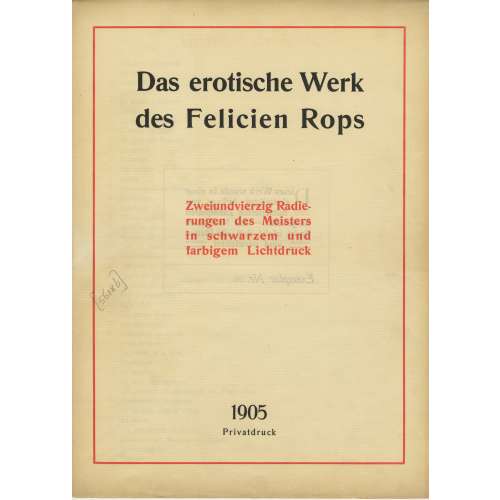
A limited-edition (№26/500) set of 42 etchings and drypoints after Félicien Rops (Belgian, 1833 – 1898), each mounted in a numbered passe-partout, printed posthumously by an anonym in Germany in 1905; in a flapped half faux suede-backed cardboard portfolio with straps, 442 x 335 mm, red embossed lettering to the front cover, bookplate of Richard Teschner (Austrian, 1879 – 1948) pasted inside.
Title-page (in a red frame): Das erotische Werk | des Felicien Rops | Zweiundvierzig Radie- | rungen des Meisters | in schwarzem und | farbigem Lichtdruck | 1905 | Privatdruk ||
Limitation (in a red two-section frame) : Dieses Werk wurde in einer | einmaligen Auflage von | 500 numerierten Exemplaren | hergestellt. — Ein Nachdruck | findet nicht statt, die Platten | == sind vernichtet == | Exemplar Nr. 26 ||
Verzeichnis der Tafeln (Table of Contents): 1. Initiation sentimentale; 2. La croix; 3. Entre-acte; 4. Holocauste; 5. La bonne hollandaise; 6. Étude; 7. La femme au pantin; 8. L’amour de Satan; 9. Au pays des féminies; 10. La volupté; 11. Evocation; 12. De castitate; 13. Joujou; 14. Vengeance d’une femme; 15. Phantasies; 16. Indolence; 17. Théâtre gaillard; 18. Appel au peuple; 19. Masques modernes; 20. Tout est grand chez les rois; 21. Marie-Madeleine; 22. L’amante du Christ; 23. Feuille de vigne; 24. La messe de Guide; 25 Viol et prostitution; 26. Le maillot; 27. Les jeunes France; 28. Les diaboliques; 29. Coquetterie au miroir; 30. Jeune homme; 31. La femme et la mort; 32. Confidence; 33. La bergère; 34. La mère aux satyrions; 35. Les exercices de dévotion de Mr. Henri Roch; 36. Mademoiselle de Maupin; 37. Le bonheur dans le crime; 38. La sirène; 39. Les cabotinages de l’amour; 40. Document sur l’impuissance d’aimer; 41. A cœur perdu; 42. Curieuse.
-
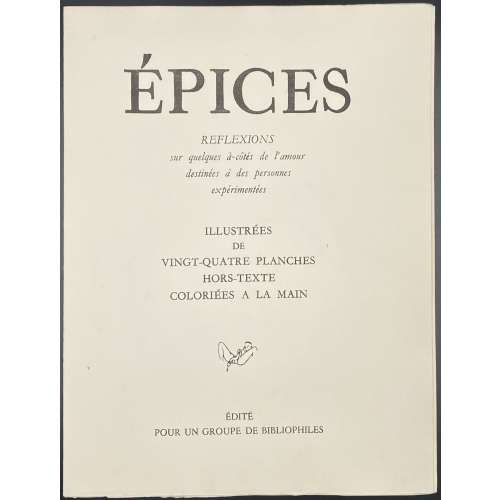 Description: French flapped wrappers, 27 x 20.5 cm, 134 gatherings, plus two leaves (blank, h.t. / limitation) at the beginning (54 leaves total), the first and the last two leaves blank, two pages in each of 12 gatherings (24 total) are hand-painted photogravures after etchings by an anonymous artist, attributed to Santippa, pseudonym of Georges or Gaston Hoffmann, or, possibly, of André Collot; the gatherings are unbound, pp. [1-10] 11-99 [100] [8] (108 pages total). Title-page: ÉPICES | REFLEXIONS | sur quelques à-côtés de l'amour | destinées à des personnes | expérimentées | ILLUSTREES | DE | VINGT-QUATRE PLANCHES | HORS-TEXTE | COLORIÉES A LA MAIN | {vignette} | ÉDITÉ | POUR UN GROUPE DE BIBLIOPHILES || Edition: limited to 500 copies numbered from 1 to 480 + 20 hand-numbered with Roman numbers. This is copy № 273. Enrichment: one original sketch (for Coucou… ou l’erreur de porte), one etching before letters and the same after letters and coloured (Le petit coin tranquille.. 19/20), and a full suite of 24 original etchings in sepia on cream paper, 20 of them on Arches and 4 on BFK Rives) printed for the first 17 copies of the 1950 edition (55 copies were printed then). In addition: one graphite pencil sketch which is not part of the suite. Catalogue raisonné: Dutel 1920 – 1970: № 1490 (for 1950), № 1491 (for 1955).
Description: French flapped wrappers, 27 x 20.5 cm, 134 gatherings, plus two leaves (blank, h.t. / limitation) at the beginning (54 leaves total), the first and the last two leaves blank, two pages in each of 12 gatherings (24 total) are hand-painted photogravures after etchings by an anonymous artist, attributed to Santippa, pseudonym of Georges or Gaston Hoffmann, or, possibly, of André Collot; the gatherings are unbound, pp. [1-10] 11-99 [100] [8] (108 pages total). Title-page: ÉPICES | REFLEXIONS | sur quelques à-côtés de l'amour | destinées à des personnes | expérimentées | ILLUSTREES | DE | VINGT-QUATRE PLANCHES | HORS-TEXTE | COLORIÉES A LA MAIN | {vignette} | ÉDITÉ | POUR UN GROUPE DE BIBLIOPHILES || Edition: limited to 500 copies numbered from 1 to 480 + 20 hand-numbered with Roman numbers. This is copy № 273. Enrichment: one original sketch (for Coucou… ou l’erreur de porte), one etching before letters and the same after letters and coloured (Le petit coin tranquille.. 19/20), and a full suite of 24 original etchings in sepia on cream paper, 20 of them on Arches and 4 on BFK Rives) printed for the first 17 copies of the 1950 edition (55 copies were printed then). In addition: one graphite pencil sketch which is not part of the suite. Catalogue raisonné: Dutel 1920 – 1970: № 1490 (for 1950), № 1491 (for 1955).

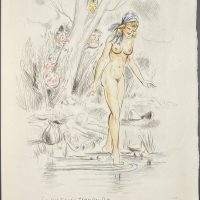
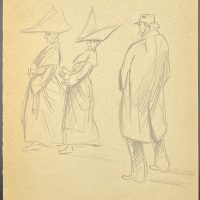
-
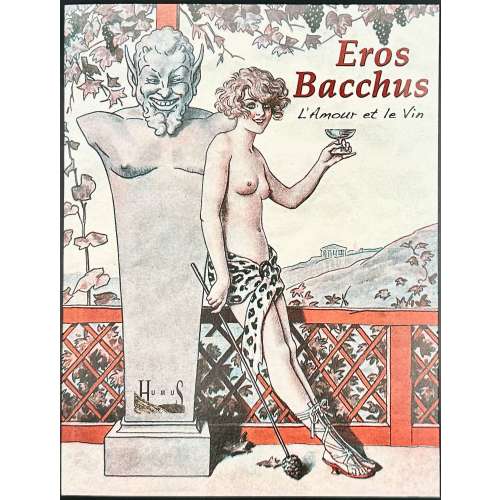 NEWBound in full-colour pictorial wrappers with French flaps, 250 x 190 x 35 mm, 1,311 g by weight, profusely illustrated volume, pp. [1-4] 5-427 [5], 216 leaves total. Title-page: {vignette} | EROS BACCHUS | L'amour et le vin | {publisher's device} || Exhibition at Château Musée du vin et de la vigne, à Aigle, du 24 mai 2014 au 28 février 2015. Text by Michel Froidevaux. Original description : Depuis l'apparition du vignoble, l'amour et le vin sont inséparables. Tantôt boisson des dieux, tantôt breuvage des poètes, le vin a la vertu de rapprocher les êtres. De la riche mythologie antique - Dionysos et Bacchus - aux fêtes des confréries contemporaines, le vin enflamme l'imaginaire et génère de la convivialité. L'idée est de proposer un parcours ludique et culturel, badin et savant pour aller par siècles et contrées à la découverte des plaisirs du boire et des méandres du désir. Livre richement illustré d'un millier d'images (dessins, objets, cartes postales,...) avec la participation d'une quarantaine d'artistes contemporains qui ont créé spécialement une œuvre. Machine translation: Love and wine have been inseparable since the dawn of the vineyard. Sometimes the drink of the gods, sometimes the beverage of poets, wine has the virtue of bringing people together. From the rich mythology of antiquity - Dionysus and Bacchus - to contemporary brotherhood celebrations, wine fires the imagination and generates conviviality. The idea is to offer a playful and cultural journey, both playful and learned, through centuries and lands, to discover the pleasures of drinking and the twists and turns of desire. The book is richly illustrated with some 1,000 images (drawings, objects, postcards, etc.), featuring works by some 40 contemporary artists.
NEWBound in full-colour pictorial wrappers with French flaps, 250 x 190 x 35 mm, 1,311 g by weight, profusely illustrated volume, pp. [1-4] 5-427 [5], 216 leaves total. Title-page: {vignette} | EROS BACCHUS | L'amour et le vin | {publisher's device} || Exhibition at Château Musée du vin et de la vigne, à Aigle, du 24 mai 2014 au 28 février 2015. Text by Michel Froidevaux. Original description : Depuis l'apparition du vignoble, l'amour et le vin sont inséparables. Tantôt boisson des dieux, tantôt breuvage des poètes, le vin a la vertu de rapprocher les êtres. De la riche mythologie antique - Dionysos et Bacchus - aux fêtes des confréries contemporaines, le vin enflamme l'imaginaire et génère de la convivialité. L'idée est de proposer un parcours ludique et culturel, badin et savant pour aller par siècles et contrées à la découverte des plaisirs du boire et des méandres du désir. Livre richement illustré d'un millier d'images (dessins, objets, cartes postales,...) avec la participation d'une quarantaine d'artistes contemporains qui ont créé spécialement une œuvre. Machine translation: Love and wine have been inseparable since the dawn of the vineyard. Sometimes the drink of the gods, sometimes the beverage of poets, wine has the virtue of bringing people together. From the rich mythology of antiquity - Dionysus and Bacchus - to contemporary brotherhood celebrations, wine fires the imagination and generates conviviality. The idea is to offer a playful and cultural journey, both playful and learned, through centuries and lands, to discover the pleasures of drinking and the twists and turns of desire. The book is richly illustrated with some 1,000 images (drawings, objects, postcards, etc.), featuring works by some 40 contemporary artists. -
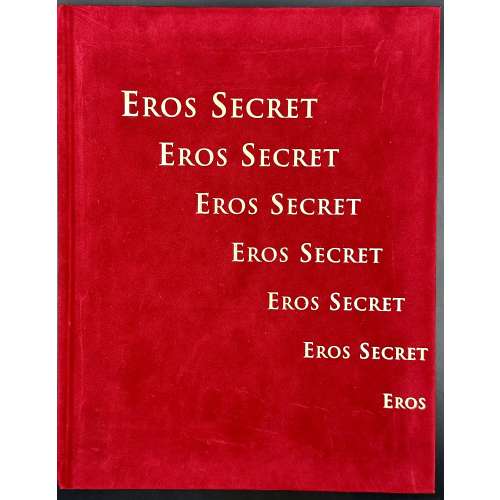 NEWHardcover volume, 290 x 225 mm, bound in scarlet velveteen with gilt lettering to front and spine, gilt vignette and lettering to back; pp.: [1-8] 9-204 [4], profusely illustrated; text in French and English. ISBN : 2-940127-37-9. Title-page (yellow on red paper): EROS SECRET | OBJETS EROTIQUES A TRANSFORMATION | EROTIC TRANSFORMATION OBJECTS | Photographies et chorégraphie : Véronique Willemin | Photographer and choreography || “The ensemble of 150 objects presented belongs to one single collector. The manner in which the author met him at the airport of Larnaca, then on a yacht in the Mediterranean sea, resembles more a novel by Gérard de Villiers than the preface of a curator but has its own touch of spice” [Art of the day Weekly].
NEWHardcover volume, 290 x 225 mm, bound in scarlet velveteen with gilt lettering to front and spine, gilt vignette and lettering to back; pp.: [1-8] 9-204 [4], profusely illustrated; text in French and English. ISBN : 2-940127-37-9. Title-page (yellow on red paper): EROS SECRET | OBJETS EROTIQUES A TRANSFORMATION | EROTIC TRANSFORMATION OBJECTS | Photographies et chorégraphie : Véronique Willemin | Photographer and choreography || “The ensemble of 150 objects presented belongs to one single collector. The manner in which the author met him at the airport of Larnaca, then on a yacht in the Mediterranean sea, resembles more a novel by Gérard de Villiers than the preface of a curator but has its own touch of spice” [Art of the day Weekly]. -
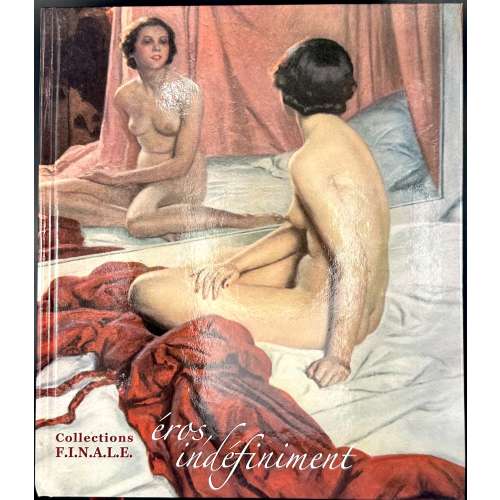 NEWHardcover volume, 297 x 256 x 40 mm, glossy pictorial boards, pp. [1-8] 9-428 [4], profusely illustrated, text in French. F.I.N.A.L.E. stands for Foundation Internationale d’Arts et Litératures Érotiques (Foundation of Erotic Arts and Literatures, established on December 12, 1996 in Lausanne, Switzerland. Title-page: éros, | indéfiniment | Collections F.I.N.A.L.E. | { HumuS, publisher’s device} ||
NEWHardcover volume, 297 x 256 x 40 mm, glossy pictorial boards, pp. [1-8] 9-428 [4], profusely illustrated, text in French. F.I.N.A.L.E. stands for Foundation Internationale d’Arts et Litératures Érotiques (Foundation of Erotic Arts and Literatures, established on December 12, 1996 in Lausanne, Switzerland. Title-page: éros, | indéfiniment | Collections F.I.N.A.L.E. | { HumuS, publisher’s device} || -
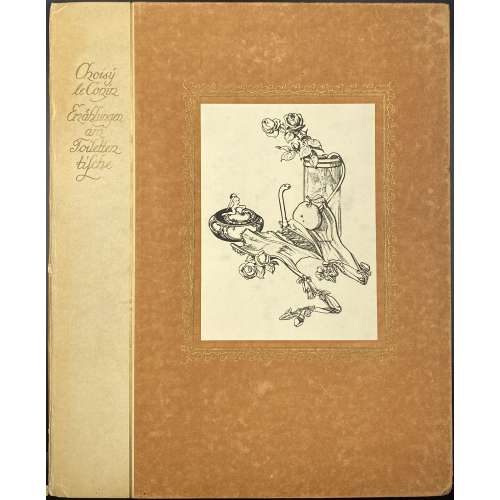 Publisher's flapped portfolio 32.8 x 26.8 cm, gilt-ruled and gilt-lettered quarter faux-parchment waxed paper over brown paper boards with pasted illustration after von Bayros within gilt arabesque frame. Possibly published in Vienna by Heinrich Conrad in 1905 or 1908. The portfolio contains the title page with a vignette and 15 loose wove paper sheets 32 x 26.2 cm of collotype reproductions after drawings by Franz von Bayros. Cover gilt lettering: Choisÿ | le Conin | Erzählungen | am | Toiletten- | tische || Title-page: Erzählungen | am Toilettentische | von | CHOISY LE CONIN | {vignette} || Title-page verso: Inhalt: | 1. Die Tabaksdose | 2. Viola de Gamba | 3. Der Bote | 4. Nicht drängeln, Kinder! | 5. Die blaue Feder | 6. O what a pretty like-place! | 7. Die Sonnenuhr |8. Der Temel der der Cotÿs | 9. Der Fetischist | 10. Jupiter und Europa | 11. Die Witwe | 12. Paroxÿsme-erotique | 13. Der Rivale | 14. Die rote Lehrerin | 15. Tantalus | Nicht im Handel. || Catalogue raisonné: The amorous drawings of the Marquis von Bayros / Part I and II. — NY: Cythera Press, 1968; pp. 95-111 [LIB-2246.2019]
Publisher's flapped portfolio 32.8 x 26.8 cm, gilt-ruled and gilt-lettered quarter faux-parchment waxed paper over brown paper boards with pasted illustration after von Bayros within gilt arabesque frame. Possibly published in Vienna by Heinrich Conrad in 1905 or 1908. The portfolio contains the title page with a vignette and 15 loose wove paper sheets 32 x 26.2 cm of collotype reproductions after drawings by Franz von Bayros. Cover gilt lettering: Choisÿ | le Conin | Erzählungen | am | Toiletten- | tische || Title-page: Erzählungen | am Toilettentische | von | CHOISY LE CONIN | {vignette} || Title-page verso: Inhalt: | 1. Die Tabaksdose | 2. Viola de Gamba | 3. Der Bote | 4. Nicht drängeln, Kinder! | 5. Die blaue Feder | 6. O what a pretty like-place! | 7. Die Sonnenuhr |8. Der Temel der der Cotÿs | 9. Der Fetischist | 10. Jupiter und Europa | 11. Die Witwe | 12. Paroxÿsme-erotique | 13. Der Rivale | 14. Die rote Lehrerin | 15. Tantalus | Nicht im Handel. || Catalogue raisonné: The amorous drawings of the Marquis von Bayros / Part I and II. — NY: Cythera Press, 1968; pp. 95-111 [LIB-2246.2019] -
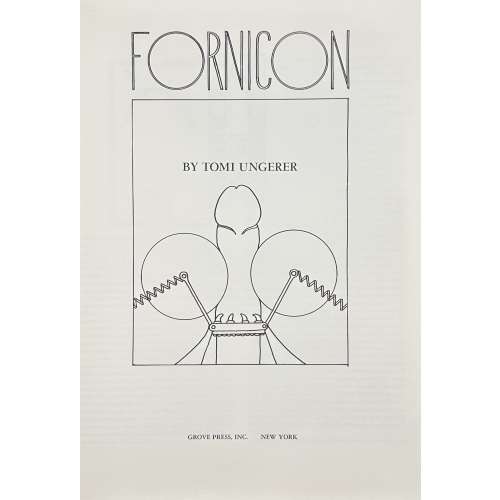 Hardcover, 333 x 247 mm, black cloth with gilt facsimile to front board and gilt lettering to spine, aubergine dust jacket with white lettering and red facsimile over black panel to front and back, crimson endpapers, laid paper, unpaginated; pp.: [4] h.t./blank, t.p./imprint, [2] text by John Hollander, 61 leaves of plates; originally published in 1969 by Rhinoceros Press, New York, as a limited-edition portfolio with slipcase. Title-page: Fornicon | (in frame) BY TOMI UNGERER | GROVE PRESS NEW YORK || Jean-Thomas [Tomi] Ungerer (French,1931 – 2019) John Hollander (American, 1929 – 2013)
Hardcover, 333 x 247 mm, black cloth with gilt facsimile to front board and gilt lettering to spine, aubergine dust jacket with white lettering and red facsimile over black panel to front and back, crimson endpapers, laid paper, unpaginated; pp.: [4] h.t./blank, t.p./imprint, [2] text by John Hollander, 61 leaves of plates; originally published in 1969 by Rhinoceros Press, New York, as a limited-edition portfolio with slipcase. Title-page: Fornicon | (in frame) BY TOMI UNGERER | GROVE PRESS NEW YORK || Jean-Thomas [Tomi] Ungerer (French,1931 – 2019) John Hollander (American, 1929 – 2013) -
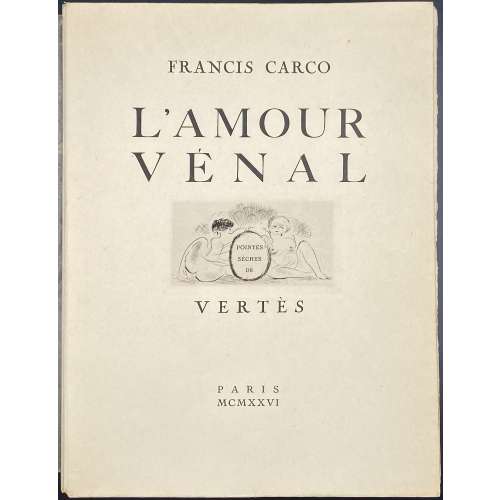 Description: One volume, publisher’s original tan French flapped wrappers with engraved vignette, in glassine DJ, unbound, 25.5 x 19.5 cm, collated in-4to, bottom and outer margins untrimmed, some pages uncut, printed on laid watermarked Van Gelder Zonen paper, illustrated with 15 full-page drypoint plates, some with tissue guard; front wrapper, t.p. and table vignettes, numerous head- and tailpieces by R. Lacourière after drawings by Marcel Vertès, enriched with two cancelled images printed on different laid papers in different states, three of each image. Printed on June 10, 1926 by Coulouma (Argenteuil) under the direction of H. Barthélemy, drypoints by Roger Lacourière (Paris). Limitation: 95 copies of which № 1 on Japon Ancien, № № 2-26 on Japon Impérial, and №№ 27-95 on Hollande. This is copy № 78. Front wrapper: FRANCIS CARCO | L'AMOUR | VÉNAL | {vignette with inscription in oval tablet «POINTES | SÈCHES | DE» } | VERTÈS | PARIS | MCMXXVI || Title-page: FRANCIS CARCO | L'AMOUR | VÉNAL | {vignette} | POINTES SÈCHES DE | VERTÈS | PARIS | MCMXXVI || Collation: 2 leaves in wrapper, π4 (fac-simile of Carco a.l.s., h.t., t.p., authorship) a4 (preface), 1-164 [17]4, 2 leaves in wrapper; total without the wrapper 76 leaves plus 15 plates, plus 6 plates of enrichment plates. Pagination: [8] [i] [ii-viii] [1] 2-128 [8], total 152 pages, ils. Note: The edition is not in Dutel, not in Pia (Enfer); Fekete (2014): № 215, p. 117; Vokaer (1967): № 15, p.10. According to both sources, it is a 2-volume edition, with text in vol. 1 and plates in vol. 2. Vokaer attributes publishing to La Roseraie (Paris) and provides for 45 drypoints of which 18 full-page plates in the second volume. Fekete (Christie’s) provides for 15 full-page plates and 25 illustrations in text. Contributors: Francis Carco [François Carcopino-Tusoli] (French, 1886 – 1958) – author. Marcel Vertès [Marcell Vértes] (Jewish-Hungarian-French, 1895 – 1961) – artist. Roger Lacourière (French, 1892 – 1966) – engraver, printer.
Description: One volume, publisher’s original tan French flapped wrappers with engraved vignette, in glassine DJ, unbound, 25.5 x 19.5 cm, collated in-4to, bottom and outer margins untrimmed, some pages uncut, printed on laid watermarked Van Gelder Zonen paper, illustrated with 15 full-page drypoint plates, some with tissue guard; front wrapper, t.p. and table vignettes, numerous head- and tailpieces by R. Lacourière after drawings by Marcel Vertès, enriched with two cancelled images printed on different laid papers in different states, three of each image. Printed on June 10, 1926 by Coulouma (Argenteuil) under the direction of H. Barthélemy, drypoints by Roger Lacourière (Paris). Limitation: 95 copies of which № 1 on Japon Ancien, № № 2-26 on Japon Impérial, and №№ 27-95 on Hollande. This is copy № 78. Front wrapper: FRANCIS CARCO | L'AMOUR | VÉNAL | {vignette with inscription in oval tablet «POINTES | SÈCHES | DE» } | VERTÈS | PARIS | MCMXXVI || Title-page: FRANCIS CARCO | L'AMOUR | VÉNAL | {vignette} | POINTES SÈCHES DE | VERTÈS | PARIS | MCMXXVI || Collation: 2 leaves in wrapper, π4 (fac-simile of Carco a.l.s., h.t., t.p., authorship) a4 (preface), 1-164 [17]4, 2 leaves in wrapper; total without the wrapper 76 leaves plus 15 plates, plus 6 plates of enrichment plates. Pagination: [8] [i] [ii-viii] [1] 2-128 [8], total 152 pages, ils. Note: The edition is not in Dutel, not in Pia (Enfer); Fekete (2014): № 215, p. 117; Vokaer (1967): № 15, p.10. According to both sources, it is a 2-volume edition, with text in vol. 1 and plates in vol. 2. Vokaer attributes publishing to La Roseraie (Paris) and provides for 45 drypoints of which 18 full-page plates in the second volume. Fekete (Christie’s) provides for 15 full-page plates and 25 illustrations in text. Contributors: Francis Carco [François Carcopino-Tusoli] (French, 1886 – 1958) – author. Marcel Vertès [Marcell Vértes] (Jewish-Hungarian-French, 1895 – 1961) – artist. Roger Lacourière (French, 1892 – 1966) – engraver, printer. -
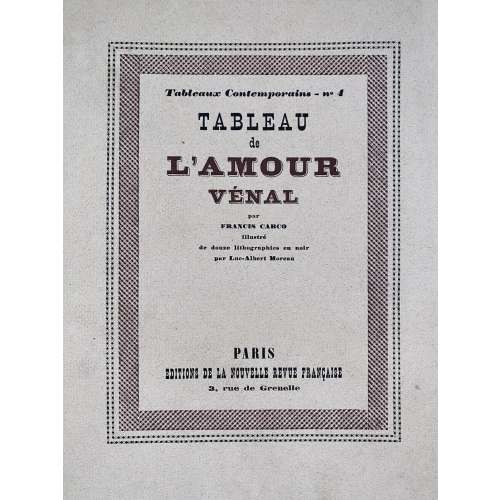 Description: Softcover, French flapped wrappers, lettered front, back (advert.) and spine, collated in-4to, 24.3 x 20.2 cm, printed on thick wove paper Vélin pur fil Lafuma-Navarre, print run limited to 335 copies from which this is copy № 219; outer margin untrimmed, some leaves uncut, glassine DJ. Limitation: 1 copy (A) on Japon Impérial + double suite of plates + suite of original drawings, 4 copies (B-E) on Japon Impérial + double suite of plates, 15 copies on on Japon Impérial + suite of plates on Vieux Japon teinté (F-T), 315 copies on Vélin pur fil Lafuma-Navarre, of which 15 (I-XV) not for sale. Copyright: Libraire Gallimard, 1924. Printed: March 10, 1924 – text by Coulouma (Argenteuil) under direction of H. Barthélemy, lithographs printed by Marchizet (Paris). Front wrapper (in letterpress two-colour border): Tableaux Contemporains – no 4 | . TABLEAU | de | L'AMOUR | VÉNAL | par | FRANCIS CARCO | Illustré | de douze lithographies en noir | par Luc-Albert Moreau | PARIS | ÉDITIONS DE LA NOUVELLE REVUE FRANÇAISE | 3, rue de Grenelle || Title-page: Same, without a frame, in black, L'AMOUR | VÉNAL in brown. Collation: 4to; 14 a4 2-164, total 68 leaves with wrappers included in collation plus 12 plates, incl. frontispiece, extraneous to collation. Pagination: [2 wrapper] [6] [i] ii-vii [viii blank] [9] 10-122 [2 colophon] [2 blank] [2 wrapper]; total 136 pages incl. wrappers, plus ils. Contributors: Francis Carco [François Carcopino-Tusoli] (French, 1886 – 1958) – author. Luc-Albert Moreau (French, 1882 – 1948) – artist. La Nouvelle Revue Française (nrf) (Paris)– publisher. Gaston Gallimard (French, 1881 – 1975) – publisher.
Description: Softcover, French flapped wrappers, lettered front, back (advert.) and spine, collated in-4to, 24.3 x 20.2 cm, printed on thick wove paper Vélin pur fil Lafuma-Navarre, print run limited to 335 copies from which this is copy № 219; outer margin untrimmed, some leaves uncut, glassine DJ. Limitation: 1 copy (A) on Japon Impérial + double suite of plates + suite of original drawings, 4 copies (B-E) on Japon Impérial + double suite of plates, 15 copies on on Japon Impérial + suite of plates on Vieux Japon teinté (F-T), 315 copies on Vélin pur fil Lafuma-Navarre, of which 15 (I-XV) not for sale. Copyright: Libraire Gallimard, 1924. Printed: March 10, 1924 – text by Coulouma (Argenteuil) under direction of H. Barthélemy, lithographs printed by Marchizet (Paris). Front wrapper (in letterpress two-colour border): Tableaux Contemporains – no 4 | . TABLEAU | de | L'AMOUR | VÉNAL | par | FRANCIS CARCO | Illustré | de douze lithographies en noir | par Luc-Albert Moreau | PARIS | ÉDITIONS DE LA NOUVELLE REVUE FRANÇAISE | 3, rue de Grenelle || Title-page: Same, without a frame, in black, L'AMOUR | VÉNAL in brown. Collation: 4to; 14 a4 2-164, total 68 leaves with wrappers included in collation plus 12 plates, incl. frontispiece, extraneous to collation. Pagination: [2 wrapper] [6] [i] ii-vii [viii blank] [9] 10-122 [2 colophon] [2 blank] [2 wrapper]; total 136 pages incl. wrappers, plus ils. Contributors: Francis Carco [François Carcopino-Tusoli] (French, 1886 – 1958) – author. Luc-Albert Moreau (French, 1882 – 1948) – artist. La Nouvelle Revue Française (nrf) (Paris)– publisher. Gaston Gallimard (French, 1881 – 1975) – publisher. -
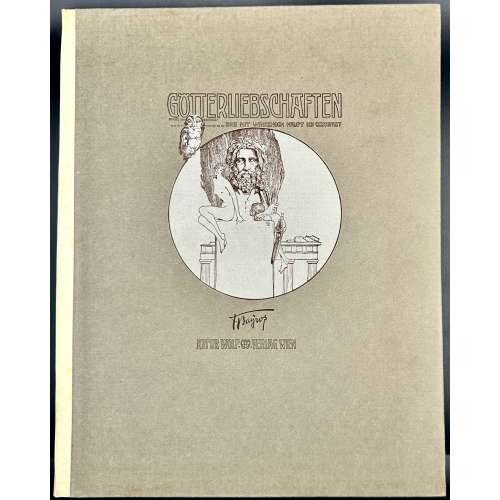 Letterpress title-page, engraved title-page, and 10 sheets of collotype plates printed on india paper mounted on thick wove paper, with captioned guard sheets, loose in a vellum-backed cardboard portfolio with cloth-mounted flaps; floral diaper design inside throughout; bookseller's label to front board verso; limited edition of 550 copies of which this is copy № 103. Dimensions: 338 x 268 mm portfolio; 325 x 260 mm sheet, 225 x 195 mm image. Front board with lettering and vignette: GÖTTERLIEBSCHAFTEN | DAS MIT WINKENDEM HAUPT ICH GEWAHRET | {vignette} | {signature} | ARTUR WOLF / VERLAG WIEN || Letterpress title-page: FRANZ VON BAYROS | “GÖTTERLIEBSCHAFTEN” | ARTUR WOLF / VERLAG WIEN | 1914 || Verso to letterpress t.p. VERZEICHNIS DER TAFELN.
Letterpress title-page, engraved title-page, and 10 sheets of collotype plates printed on india paper mounted on thick wove paper, with captioned guard sheets, loose in a vellum-backed cardboard portfolio with cloth-mounted flaps; floral diaper design inside throughout; bookseller's label to front board verso; limited edition of 550 copies of which this is copy № 103. Dimensions: 338 x 268 mm portfolio; 325 x 260 mm sheet, 225 x 195 mm image. Front board with lettering and vignette: GÖTTERLIEBSCHAFTEN | DAS MIT WINKENDEM HAUPT ICH GEWAHRET | {vignette} | {signature} | ARTUR WOLF / VERLAG WIEN || Letterpress title-page: FRANZ VON BAYROS | “GÖTTERLIEBSCHAFTEN” | ARTUR WOLF / VERLAG WIEN | 1914 || Verso to letterpress t.p. VERZEICHNIS DER TAFELN.- Europa und der Stier
- Leda und die Schildkröte
- Sterope und Herkules
- Herodikos und die Turnerinnen
- Phoroneus und die Hirtin
- Minos und Persipeia
- Phryne und Mutter
- Pytalos und Demeter
- Kirke und die Ferkel
- Putiphar
-
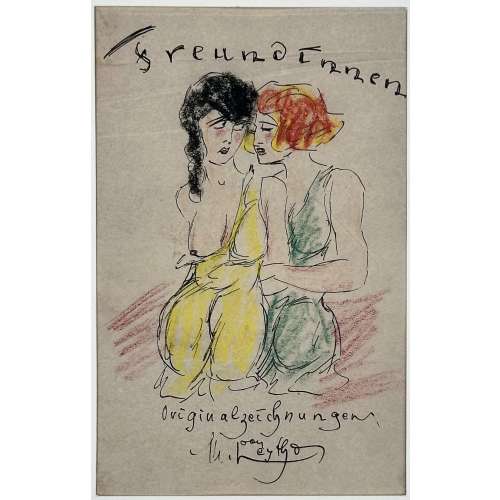 Seven pen and ink and colour crayon drawings on thin wove paper approx. 140 x 100 mm, each attached to a sheet 310 x 240 mm and mounted in a passepartout, placed in an aubergine cardboard folder 310 x 250 mm with a tan vellum spine and paper flaps inside; olive label with double border and gilt lettering to front cover "Dessins" [Drawings]. The first sheet is a title-page lettered in manuscript: Freundinnen | {vignette} | Originalzeichnungen | M. Leytho || [Girlfriends. Original drawings]. Information about the artist at www.honesterotica.com: "Mitja Leytho, almost certainly a pseudonym, is yet another mediocre yet fascinating amateur artist from the Germany of the 1920s about whom we know absolutely nothing beyond the four portfolios which bear the ‘Leytho’ signature". We shall notice that this set of drawings was produced by a talented professional, not an amateur.
Seven pen and ink and colour crayon drawings on thin wove paper approx. 140 x 100 mm, each attached to a sheet 310 x 240 mm and mounted in a passepartout, placed in an aubergine cardboard folder 310 x 250 mm with a tan vellum spine and paper flaps inside; olive label with double border and gilt lettering to front cover "Dessins" [Drawings]. The first sheet is a title-page lettered in manuscript: Freundinnen | {vignette} | Originalzeichnungen | M. Leytho || [Girlfriends. Original drawings]. Information about the artist at www.honesterotica.com: "Mitja Leytho, almost certainly a pseudonym, is yet another mediocre yet fascinating amateur artist from the Germany of the 1920s about whom we know absolutely nothing beyond the four portfolios which bear the ‘Leytho’ signature". We shall notice that this set of drawings was produced by a talented professional, not an amateur. -
 Title: GIACOMO CASANOVA | Chevalier de Seingalt | HISTORY OF MY LIFE | FIRST TRANSLATED INTO ENGLISH IN ACCORDANCE | WITH THE ORIGINAL FRENCH MANUSCRIPT | By Willard R. Trask | With an Introduction by the Translator | VOLUMES 1 AND 2 | A Helen and Kurt Wolff book • Harcourt, Brace & World, 1966 | NEW YORK || Stated 1st edition. Pagination: [2 blank] [i-iv] v-viii, [1, 2] 3-330 [8 blanks] + 32 ills. Two volumes in one.
Title: GIACOMO CASANOVA | Chevalier de Seingalt | HISTORY OF MY LIFE | FIRST TRANSLATED INTO ENGLISH IN ACCORDANCE | WITH THE ORIGINAL FRENCH MANUSCRIPT | By Willard R. Trask | With an Introduction by the Translator | VOLUMES 1 AND 2 | A Helen and Kurt Wolff book • Harcourt, Brace & World, 1966 | NEW YORK || Stated 1st edition. Pagination: [2 blank] [i-iv] v-viii, [1, 2] 3-330 [8 blanks] + 32 ills. Two volumes in one. -
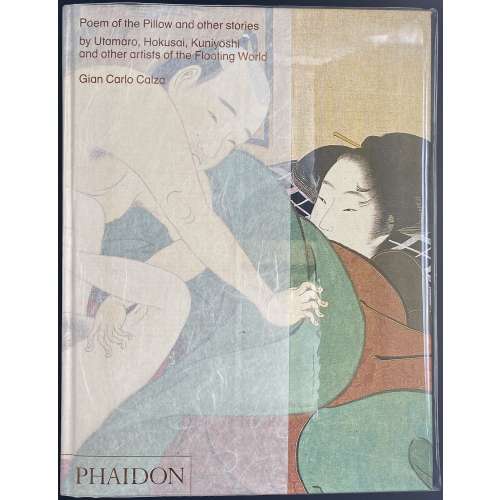 A pictorial album with almost no information (coffee-table book), hardcover, 28 x 21 x 4.8 cm, in pictorial paper boards, lettered all over, in transparent plastic dust jacket; pp.: [1-5] 6-463 [464 colophon], total 232 leaves, illustrated in colour throughout. Title-page: Poem of the Pillow and other stories | by Utamaro, Hokusai, Kuniyoshi | and other artists of the Floating World | Gian Carlo Calza | In collaboration with Stefania Piotti | {publisher’s device “Φ” in the bottom} || Contributors: Gian Carlo Calza (Italian, b. 1940); Stefania Piotti (Italian).
A pictorial album with almost no information (coffee-table book), hardcover, 28 x 21 x 4.8 cm, in pictorial paper boards, lettered all over, in transparent plastic dust jacket; pp.: [1-5] 6-463 [464 colophon], total 232 leaves, illustrated in colour throughout. Title-page: Poem of the Pillow and other stories | by Utamaro, Hokusai, Kuniyoshi | and other artists of the Floating World | Gian Carlo Calza | In collaboration with Stefania Piotti | {publisher’s device “Φ” in the bottom} || Contributors: Gian Carlo Calza (Italian, b. 1940); Stefania Piotti (Italian).
List of the artists: The Kanbun Master, Hishikawa Moronobu, Sugimura Jihei, Torii Kiyonobu I, Nishikawa Sukenobu, Miyagawa Chōshun, Okumura Masanobu, Tsukioka Settei, Suzuki Harunobu, Isoda Koryūsai, Katsukawa Shunshō, Katsukawa Shunchō, Kitao Masanobu, Torii Kiyonaga, Kitagawa Utamaro, Chōbunsai Eishi, Chōkyōsai Eiri, Katsushika Hokusai, Utagawa Toyokuni, Utagawa Kunisada, Kikugawa Eizan, Keisai Eisen, Utagawa Kuniyoshi."Poem of the Pillow and Other Stories examines the artistic developments of Japanese erotic art from the ukiyo-e period, dating from the mid-seventeenth century to the end of the nineteenth century. Known by the delicate euphemism of Shunga or 'spring images', these pictures were hugely popular and admired, and are today highly collectable works of art. This book illustrates major Shunga works from important ukiyo-e masters such as Utamaro, Hokusai, Harunobu, Kunisada, Kuniyoshi and many others. World-renowned scholar Gian Carlo Calza defines these fascinating erotic works in their social, historical and artistic context, providing a broad overview of a subject that is extremely nuanced and intriguing. Beautifully illustrated with over 300 images, including woodblock prints, scrolls and paintings, this book is a perfect introduction to ukiyo-e erotic art." -
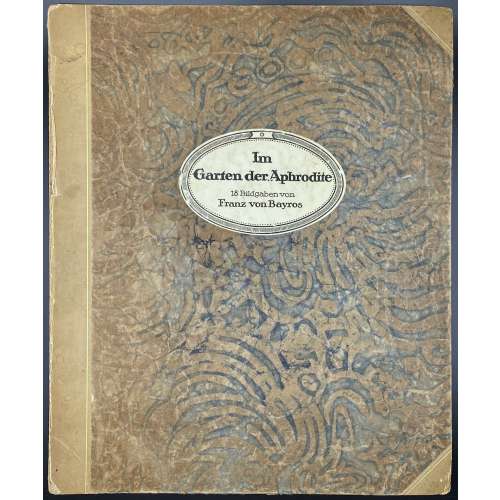 Cover with title: Im Garten der Aphrodite | 18 Bildgaben | von | Franz von Bayros | {vignette} | Privatdruck || in a frame; table of contents and limitation to verso; 18 plates with the drawings of Bayros in collotype reproduction, each mounted on cardboard and protected with the remnants of tissue guards, some lacking. Of the publisher’s folder, only the front board with an oval title label is present. Some images signed “Choisy le Conin” – von Bayros’s pseudonym. Two prints are missing: (1) Das Füßchen and (2) Die Liebesschaukel, the other 16 prints present. The vignette on the cover is a photomechanical reproduction. Edition: limited to 350 copies of which this is № 253. According to Christie’s: a collotype reprint, about twenty years after their first publication. English equivalent: The Garden of Aphrodite. Portfolio with 18 photogravures. Catalogue raisonné: The amorous drawings of the Marquis von Bayros (1968): pp. 177-1877; Bayros Zeichningen (1987): pp. 143-152.
Cover with title: Im Garten der Aphrodite | 18 Bildgaben | von | Franz von Bayros | {vignette} | Privatdruck || in a frame; table of contents and limitation to verso; 18 plates with the drawings of Bayros in collotype reproduction, each mounted on cardboard and protected with the remnants of tissue guards, some lacking. Of the publisher’s folder, only the front board with an oval title label is present. Some images signed “Choisy le Conin” – von Bayros’s pseudonym. Two prints are missing: (1) Das Füßchen and (2) Die Liebesschaukel, the other 16 prints present. The vignette on the cover is a photomechanical reproduction. Edition: limited to 350 copies of which this is № 253. According to Christie’s: a collotype reprint, about twenty years after their first publication. English equivalent: The Garden of Aphrodite. Portfolio with 18 photogravures. Catalogue raisonné: The amorous drawings of the Marquis von Bayros (1968): pp. 177-1877; Bayros Zeichningen (1987): pp. 143-152. -
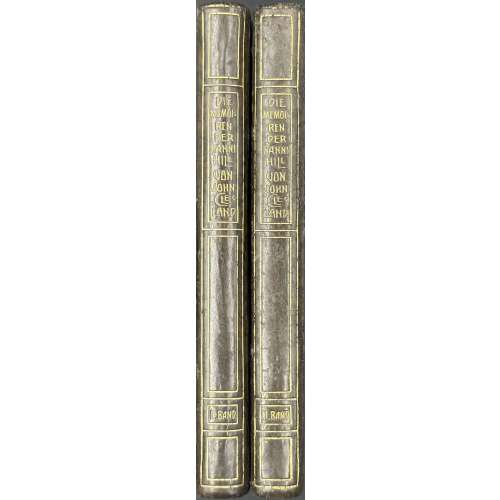 Two hardcover volumes, 17 x 11.5 cm, collated in-8vo, uniformly bound in dark grey mottled calf bordered with gilt fillet, flat spine with gilt lettering in compartments outlined in gilt; top edge gilt, text and plates printed on dense wove paper (Japanpapier). Privately printed by Gustav Röttig & Sohn (Ödenburg) in 800 copies, of which this is copy № 16, signed by von Bayros in 1st vol. Each volume is illustrated with four heliogravures (title-page and three plates) after drawings by Franz von Bayros. According to the seller, this is one of only 35 copies of the deluxe edition on Japanpapier, a fact which was mentioned by the bibliographers but not in the imprint. Bookplate to front pastedown in each volume, lettering to bottom “Ex libris Dr. phil. Rudolf Ludwig”, 120 x 100 mm, heliogravure after von Bayros. Pp.: vol. 1 [4] 1-198 plus engraved t.p. and 3 plates. Vol. 2: 1-204 [2] plus engraved t.p. and 3 plates. Title-page: DIE MEMOIREN | DER | FANNY HILL | VON | JOHN CLELAND | ESTER (ZWEITER) BAND | PAPHOS IM JAHR DER | CYTHERE | MDCCCCVI || Author of the text: John Cleland (British, c. 1709 – 1789). Translator: Franz Blei [Dr. Erich Feldhammer] (Austrian, 1871 – 1942). Illustrator: Franz von Bayros (Austrian, 1866 – 1924). Provenance: Dr. Phil. Rudolf Ludwig. Catalogue raisonné: The amorous drawings of the Marquis von Bayros. — New York: Cythera Press, 1968. The Beautiful Maiden of Pao, pp. 31-38. Seller's Description: Erster [und] Zweiter Band. Paphos [Wien, C. W. Stern], im Jahr der Cythere 1906. Mit sechs Tafeln und zwei illustrierten Titeln nach Franz von Bayros, alle zweifarbig. Grau marmorierte Originalkalblederbände mit Rücken-, Deckelkanten- und Kopfschnittvergoldung. Privatdruck. – Eins von 35 Exemplaren der Luxusausgabe auf Japanpapier, im Druckvermerk von Band I von Bayros signiert. – Die Übersetzung stammt von Franz Blei, der hier unter dem Pseudonym Dr. Erich Feldhammer genannt wird. Als Textvorlage diente die Ausgabe London 1749. – Gedruckt wurde bei Gustav Röttig & Sohn in Ödenburg. – Sehr seltene Vorzugsausgabe, die zwar bei den Bibliographen, nicht aber im Druckvermerk genannt wurde. – Fast tadellos. – »Dieses Werk ist eines der berühmtesten in der erotischen Literatur« (Stern-Szana). Nach Hinweis bei Brettschneider wurde die Auflage beschlagnahmt. – Exlibris Dr. phil. Rudolf Ludwig, Wien (Heliogravüre nach Zeichnung von Franz von Bayros, Brettschneider 156) in beiden Bänden. 17 : 11,5 cm. [4], 198, [2], [4], 204, [2] Seiten. Zusammen 8 Tafeln. Brettschneider 38. – Hayn/Gotendorf I, 618. – Stern-Szana 243 und ausführlich S. 222ff
Two hardcover volumes, 17 x 11.5 cm, collated in-8vo, uniformly bound in dark grey mottled calf bordered with gilt fillet, flat spine with gilt lettering in compartments outlined in gilt; top edge gilt, text and plates printed on dense wove paper (Japanpapier). Privately printed by Gustav Röttig & Sohn (Ödenburg) in 800 copies, of which this is copy № 16, signed by von Bayros in 1st vol. Each volume is illustrated with four heliogravures (title-page and three plates) after drawings by Franz von Bayros. According to the seller, this is one of only 35 copies of the deluxe edition on Japanpapier, a fact which was mentioned by the bibliographers but not in the imprint. Bookplate to front pastedown in each volume, lettering to bottom “Ex libris Dr. phil. Rudolf Ludwig”, 120 x 100 mm, heliogravure after von Bayros. Pp.: vol. 1 [4] 1-198 plus engraved t.p. and 3 plates. Vol. 2: 1-204 [2] plus engraved t.p. and 3 plates. Title-page: DIE MEMOIREN | DER | FANNY HILL | VON | JOHN CLELAND | ESTER (ZWEITER) BAND | PAPHOS IM JAHR DER | CYTHERE | MDCCCCVI || Author of the text: John Cleland (British, c. 1709 – 1789). Translator: Franz Blei [Dr. Erich Feldhammer] (Austrian, 1871 – 1942). Illustrator: Franz von Bayros (Austrian, 1866 – 1924). Provenance: Dr. Phil. Rudolf Ludwig. Catalogue raisonné: The amorous drawings of the Marquis von Bayros. — New York: Cythera Press, 1968. The Beautiful Maiden of Pao, pp. 31-38. Seller's Description: Erster [und] Zweiter Band. Paphos [Wien, C. W. Stern], im Jahr der Cythere 1906. Mit sechs Tafeln und zwei illustrierten Titeln nach Franz von Bayros, alle zweifarbig. Grau marmorierte Originalkalblederbände mit Rücken-, Deckelkanten- und Kopfschnittvergoldung. Privatdruck. – Eins von 35 Exemplaren der Luxusausgabe auf Japanpapier, im Druckvermerk von Band I von Bayros signiert. – Die Übersetzung stammt von Franz Blei, der hier unter dem Pseudonym Dr. Erich Feldhammer genannt wird. Als Textvorlage diente die Ausgabe London 1749. – Gedruckt wurde bei Gustav Röttig & Sohn in Ödenburg. – Sehr seltene Vorzugsausgabe, die zwar bei den Bibliographen, nicht aber im Druckvermerk genannt wurde. – Fast tadellos. – »Dieses Werk ist eines der berühmtesten in der erotischen Literatur« (Stern-Szana). Nach Hinweis bei Brettschneider wurde die Auflage beschlagnahmt. – Exlibris Dr. phil. Rudolf Ludwig, Wien (Heliogravüre nach Zeichnung von Franz von Bayros, Brettschneider 156) in beiden Bänden. 17 : 11,5 cm. [4], 198, [2], [4], 204, [2] Seiten. Zusammen 8 Tafeln. Brettschneider 38. – Hayn/Gotendorf I, 618. – Stern-Szana 243 und ausführlich S. 222ff -
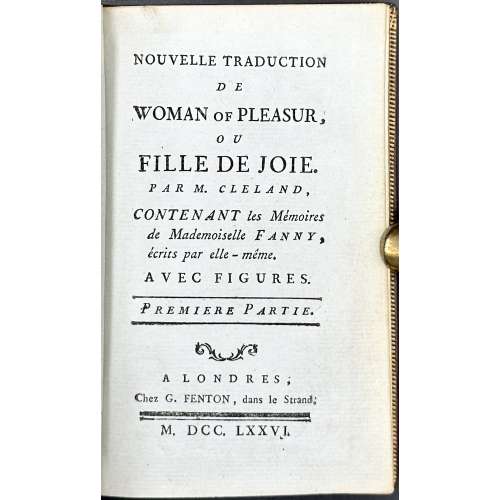 Hardcover volume, collated 18mo, 130 x 85 mm (2 parts in one). Contemporary burgundy morocco outlined with gilt triple fillet, flat spine gilt in compartments, brown morocco label gilt, all edges gilt, gilt dentelle, text printed on slightly blue laid paper with illegible watermark; dark blue endpapers, Tony Fekete (T. F.) bookplate by Wahorn to front pastedown. Frontispiece and 14 engraved plates by Elluin after Borel, with guard tissue. Graphite ms to h.t.: "Figures de Borrel. | Gravées pr. Elluin." Title-page: NOUVELLE TRADUCTION | DE | WOMAN OF PLEASUR, | OU | FILLE DE JOIE. | PAR M. CLELAND, | CONTENANT les Mémoires | de Mademoiselle FANNY, | écrits par elle – même. | AVEC FIGURES | — | PREMIERE (SECONDE) PARTIE. | — | ~ | A LONDRES; | Chez G. FENTON, dans le Strand; | — | M. DCC. LXXVI. || Collation: 18mo throughout A-O12/6, total 126 leaves plus 15 plates, incl. frontispiece. Pagination: separate for each part [1-5] 6-119 [120 blank], [1-3] 4-132, total 252 pages. Provenance: Tony Fekete (Christie’s 2014, № 54, p. 37; Price realized GBP 11,875): “[CLELAND, John (1709-1789).] Nouvelle traduction de Woman of Pleasur [sic] ou Fille de Joie. Contenant les Mémoires de Mademoiselle Fanny, écrits par elle-même. London [but Paris]: G. Fenton [Cazin], 1776. 2 volumes in one, duodecimo (128 x 80 mm). Printed on blue tinted paper. Frontispiece and 14 engraved plates on thick white paper by Elluin after Borel. (Short tear repaired in the margin of one plate, another plate with a faint dampstain touching the facing leaf of text.) Contemporary burgundy morocco, flat spine gilt in compartments, morocco label gilt, covers with a gilt triple fillet border, gilt edges, blue endpapers. THE MOST BEAUTIFUL 18TH-CENTURY ILLUSTRATED EDITION OF THIS CELEBRATED EROTIC NOVEL. An excellent copy bound in contemporary morocco. It is the second translation into French, but the first to include the exquisite plates by Elluin after Borel. These are some of the best illustrations by this remarkable partnership responsible for a number of important 18th-century libertine texts. Cohen-DeRicci 242-3; Dutel A-407 ; Gay-Lemonnyer II, 304; Pia Enfer, 915.” Catalogue raisonné: Dutel (I) A-407, p. 134; Cohen-DeRicci 242-3; Fekete (Christie's) 54, p. 37. Contributors: John Cleland (British, c. 1709 – 1789). François-Rolland Elluin (French, 1745 – c. 1822) Antoine Borel (French, 1743 – 1810) Hubert-Martin Cazin (French, 1724 – 1795) András Wahorn (Hungarian, b. 1953) Fekete, Tony Laszlo (Hungarian, b. 1972)
Hardcover volume, collated 18mo, 130 x 85 mm (2 parts in one). Contemporary burgundy morocco outlined with gilt triple fillet, flat spine gilt in compartments, brown morocco label gilt, all edges gilt, gilt dentelle, text printed on slightly blue laid paper with illegible watermark; dark blue endpapers, Tony Fekete (T. F.) bookplate by Wahorn to front pastedown. Frontispiece and 14 engraved plates by Elluin after Borel, with guard tissue. Graphite ms to h.t.: "Figures de Borrel. | Gravées pr. Elluin." Title-page: NOUVELLE TRADUCTION | DE | WOMAN OF PLEASUR, | OU | FILLE DE JOIE. | PAR M. CLELAND, | CONTENANT les Mémoires | de Mademoiselle FANNY, | écrits par elle – même. | AVEC FIGURES | — | PREMIERE (SECONDE) PARTIE. | — | ~ | A LONDRES; | Chez G. FENTON, dans le Strand; | — | M. DCC. LXXVI. || Collation: 18mo throughout A-O12/6, total 126 leaves plus 15 plates, incl. frontispiece. Pagination: separate for each part [1-5] 6-119 [120 blank], [1-3] 4-132, total 252 pages. Provenance: Tony Fekete (Christie’s 2014, № 54, p. 37; Price realized GBP 11,875): “[CLELAND, John (1709-1789).] Nouvelle traduction de Woman of Pleasur [sic] ou Fille de Joie. Contenant les Mémoires de Mademoiselle Fanny, écrits par elle-même. London [but Paris]: G. Fenton [Cazin], 1776. 2 volumes in one, duodecimo (128 x 80 mm). Printed on blue tinted paper. Frontispiece and 14 engraved plates on thick white paper by Elluin after Borel. (Short tear repaired in the margin of one plate, another plate with a faint dampstain touching the facing leaf of text.) Contemporary burgundy morocco, flat spine gilt in compartments, morocco label gilt, covers with a gilt triple fillet border, gilt edges, blue endpapers. THE MOST BEAUTIFUL 18TH-CENTURY ILLUSTRATED EDITION OF THIS CELEBRATED EROTIC NOVEL. An excellent copy bound in contemporary morocco. It is the second translation into French, but the first to include the exquisite plates by Elluin after Borel. These are some of the best illustrations by this remarkable partnership responsible for a number of important 18th-century libertine texts. Cohen-DeRicci 242-3; Dutel A-407 ; Gay-Lemonnyer II, 304; Pia Enfer, 915.” Catalogue raisonné: Dutel (I) A-407, p. 134; Cohen-DeRicci 242-3; Fekete (Christie's) 54, p. 37. Contributors: John Cleland (British, c. 1709 – 1789). François-Rolland Elluin (French, 1745 – c. 1822) Antoine Borel (French, 1743 – 1810) Hubert-Martin Cazin (French, 1724 – 1795) András Wahorn (Hungarian, b. 1953) Fekete, Tony Laszlo (Hungarian, b. 1972) -
 Artist: Kitagawa Utamaro [喜多川 歌麿] (Japanese, c. 1753 – 1806) "This uncommon half-size horizontal ōban ... is most likely one design from a set of twelve prints issued late in Utamaro's life" [Japanese Erotic Fantasies, Hotei Publishing, 2005, p. 143, pl. 47]. Half-size horizontal ōban must be 12.7 x 38 cm. Richard Waldman and Chris Uhlenbeck say it's tanzaku size (13 x 43 cm). In reality, the prints of this series measure 17 x 38 cm, which corresponds exactly to horizontal o-hosoban paper size. I managed to assemble 11 of allegedly 12 designs. 7 of them have genitals colored by hand. It's hard to tell whether it was done by the publisher on demand of a peculiar buyer, or by the owner of the prints who considered the black and white privy parts unnatural. My sequencing of the prints is arbitrary. Transcription of the text may help find the correct order.
Artist: Kitagawa Utamaro [喜多川 歌麿] (Japanese, c. 1753 – 1806) "This uncommon half-size horizontal ōban ... is most likely one design from a set of twelve prints issued late in Utamaro's life" [Japanese Erotic Fantasies, Hotei Publishing, 2005, p. 143, pl. 47]. Half-size horizontal ōban must be 12.7 x 38 cm. Richard Waldman and Chris Uhlenbeck say it's tanzaku size (13 x 43 cm). In reality, the prints of this series measure 17 x 38 cm, which corresponds exactly to horizontal o-hosoban paper size. I managed to assemble 11 of allegedly 12 designs. 7 of them have genitals colored by hand. It's hard to tell whether it was done by the publisher on demand of a peculiar buyer, or by the owner of the prints who considered the black and white privy parts unnatural. My sequencing of the prints is arbitrary. Transcription of the text may help find the correct order. As Japanese Erotic Fantasies put it: "a couple engaged in love-making, their stare fixed outside the picture plane". This is the only image of series that has a reference in available western literature, and the only one found in museum collections: Rijksmuseum Amsterdam (RP-P-1999-2001-16); reference: Fukuda (ed.) (1990), pls. 11-2.
As Japanese Erotic Fantasies put it: "a couple engaged in love-making, their stare fixed outside the picture plane". This is the only image of series that has a reference in available western literature, and the only one found in museum collections: Rijksmuseum Amsterdam (RP-P-1999-2001-16); reference: Fukuda (ed.) (1990), pls. 11-2.
 The scene of this print looks quite similar to that of the Kiyonaga's Sode no maki:
The scene of this print looks quite similar to that of the Kiyonaga's Sode no maki:
 The woman is "a young lady-in-waiting of Shogun's Court or Daimyō's Mansion, enjoying a rare outing from her tedious chores" [Richard Lane]. She is fully dressed in her outer cloak (shikake), white paper hat (agebōshi or tsunokakushi), and toed socks (tabi). A book or maybe, onkotogami (roll of tissues known as 'paper for honourable act' ) is still in the folds of her kimono. She is holding an open fan, either to cover her and her lover's faces from an unsolicited witness or to bring some fresh air to their joined lips. The pair just started their sexual intercourse.
The woman is "a young lady-in-waiting of Shogun's Court or Daimyō's Mansion, enjoying a rare outing from her tedious chores" [Richard Lane]. She is fully dressed in her outer cloak (shikake), white paper hat (agebōshi or tsunokakushi), and toed socks (tabi). A book or maybe, onkotogami (roll of tissues known as 'paper for honourable act' ) is still in the folds of her kimono. She is holding an open fan, either to cover her and her lover's faces from an unsolicited witness or to bring some fresh air to their joined lips. The pair just started their sexual intercourse.
 A scene from medieval times. A courtier in eboshi cap having sex with an aristocratic young woman with a long straight hairstyle (suihatsu).
A scene from medieval times. A courtier in eboshi cap having sex with an aristocratic young woman with a long straight hairstyle (suihatsu).
 Completely naked couple in the moment of ejaculation. Lavish garments with paulownia leaves on a yellow background counterbalance the white bodies on red bedding. The form of a woman's cheeks is telling, but I don't know about what. Maybe her advanced age?
Completely naked couple in the moment of ejaculation. Lavish garments with paulownia leaves on a yellow background counterbalance the white bodies on red bedding. The form of a woman's cheeks is telling, but I don't know about what. Maybe her advanced age?
 The pose of the couple and the overall composition are similar to that of the previous sheet. Though the lovers are dressed, and the woman's hairdo is well kept. The male looks older and the woman - younger.
The pose of the couple and the overall composition are similar to that of the previous sheet. Though the lovers are dressed, and the woman's hairdo is well kept. The male looks older and the woman - younger.
 A man takes a young maid from behind. She clenches the sleeve of her kimono in her teeth; it's either the moment of penetration (beginning of intercourse) or of her orgasm (the end of it).
A man takes a young maid from behind. She clenches the sleeve of her kimono in her teeth; it's either the moment of penetration (beginning of intercourse) or of her orgasm (the end of it).
 This seems to be a forced intercourse between a lackey with extensive bodily hair and a young maid from the same household.
This seems to be a forced intercourse between a lackey with extensive bodily hair and a young maid from the same household.
 This design is very much like the other one presented below, which is described at Japanese Erotic Fantasies on page 136 (pl. 43b) as follows: "The viewer peers through a mosquito net to see a child fast asleep, while his mother or wet-nurse moves towards her partner. On our print there is no child; instead of a sleeping baby, there is a roll of onkotogami. Fewer objects make the overall image concise, almost laconic in comparison with the Ehon hana fubuki (1802) design:
This design is very much like the other one presented below, which is described at Japanese Erotic Fantasies on page 136 (pl. 43b) as follows: "The viewer peers through a mosquito net to see a child fast asleep, while his mother or wet-nurse moves towards her partner. On our print there is no child; instead of a sleeping baby, there is a roll of onkotogami. Fewer objects make the overall image concise, almost laconic in comparison with the Ehon hana fubuki (1802) design:

 A young couple in a moment of true love. He is listening to the beating of her heart.
A young couple in a moment of true love. He is listening to the beating of her heart.
 This is a moment of true love between an old monk and a young samurai. The latter even did not take of his socks (tabi).
This is a moment of true love between an old monk and a young samurai. The latter even did not take of his socks (tabi).
 From Japanese Erotic Fantasies: "Boats played a crucial role in the workings of Yoshiwara, as they were the primary means of transport to the district. During the hot summer months, trips on pleasure boats were also a favourite pastime. Sex aboard a boat is a recurrent theme in shunga".
The last print that I am currently lacking and hunting for:
From Japanese Erotic Fantasies: "Boats played a crucial role in the workings of Yoshiwara, as they were the primary means of transport to the district. During the hot summer months, trips on pleasure boats were also a favourite pastime. Sex aboard a boat is a recurrent theme in shunga".
The last print that I am currently lacking and hunting for:
 I know where it is, but I cannot reach it... yet.
I know where it is, but I cannot reach it... yet. -
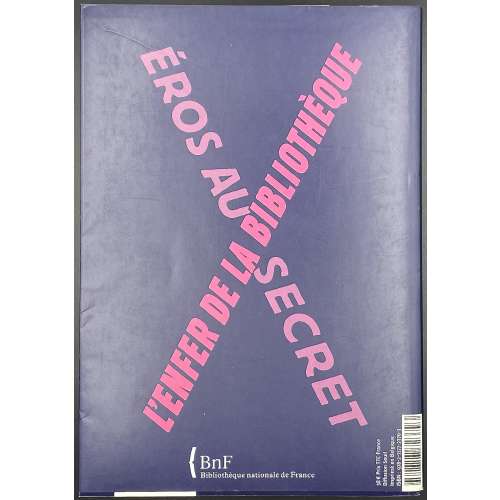 Exhibition held December 4, 2007, to March 2, 2008, at the Bibliothèque Nationale de France. Title: L'enfer de la Bibliothèque | ÉROS AU SECRET | Sous la direction | de Marie-Françoise Quignard | et Raymond-Josué Seckel | [spase] | {BnF | Bibliothèque nationale de France || Description: 23 x 16 cm, publisher’s lettered wrappers and pictorial dust jacket, [1-17] 18-460 [4], ils.; 257 entries, 8 pp. bibliography, 10 pp. index.
Exhibition held December 4, 2007, to March 2, 2008, at the Bibliothèque Nationale de France. Title: L'enfer de la Bibliothèque | ÉROS AU SECRET | Sous la direction | de Marie-Françoise Quignard | et Raymond-Josué Seckel | [spase] | {BnF | Bibliothèque nationale de France || Description: 23 x 16 cm, publisher’s lettered wrappers and pictorial dust jacket, [1-17] 18-460 [4], ils.; 257 entries, 8 pp. bibliography, 10 pp. index. -
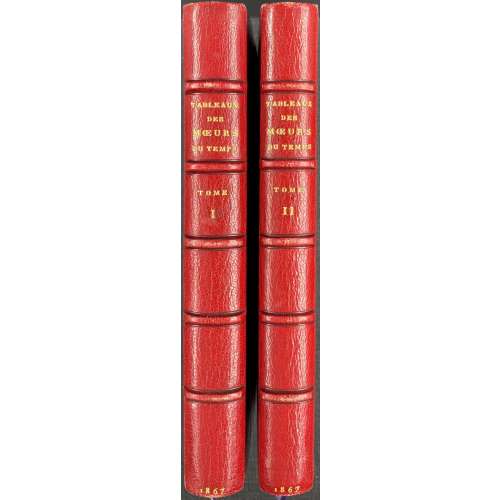 Two volumes in-12, 16.8 x 11.5 cm each, uniformly bound in ¾ red crushed morocco over marbled boards, spine with raised bands and gilt lettering, marbled endpapers, text printed on laid paper, 6 plates (3 in each vol.) on India paper pasted in on thick laid paper leaves. This edition seems similar to Nordmann I 203 but without Félicien Rops' frontispiece and plates, replaced by unsigned etchings attributed to Gustave Staal. Title-page (red and black): LE RICHE DE LA POPELINIÈRE | – | TABLEAUX | DES | MŒURS DU TEMPS | DANS LES DIFFÉRENTS AGES DE LA VIE | – | NOTICE DE | CHARLES MONSELET | – | TOME PREMIER (SECOND) | {fleuron} | PARIS | IMPRIMERIE DES CI-DEVANT FERMIERS GÉNÉRAUX | – | M D CCC L XVII || Vol. 1: π2 (h.t., t.p.) a4 (Notice), 1-1312 151 (Table); total 91 leaves plus three leaves of plates. Pagination: [4] [i] ii-vii [viii] [3] 4-168 [2]; total 182 pp, ils. facing pp. 59, 78, and 94. Vol. 2: π2 (h.t., t.p.), 1-1312, 152; total 88 leaves plus three leaves of plates. Pagination: [4] [1] 2-170 [2]; total 176 pp, ils. facing pp. 74, 78, and 145. Catalogue raisonné: Dutel I: A-1044 — without Félicien Rops ‘ornementations’, but with ‘6 gravures de 1865’. Dutel suggests that the edition was performed by A. Poulet-Malassis, Briard or Lécrivain. Catalogue Poulet-Malassis & ses amis description: № 43. LE RICHE DE LA POPELINIÈRE. Tableaux des mœurs du temps dans les diérents âges de la vie, tome premier (— second). Notice de M. Charles Monselet. Imprimerie des ci-devant fermiers généraux, Paris, M D CCC LXVII [A. Poulet-Malassis, 1867]. Exemplaire sans le frontispice de Félicien Rops mais bien complet des 6 figures de Staal, justification qui illustre les aléas de la confection des publications clandestines. D’une part, c’est une autre édition qui est décrite par Launay. L’exemplaire vendu chez Maître Loudmer avait 6 figures, comme ici. Cluzel a vu un “front. et 4 vignettes de Rops plus cinq figures libres (par Staal)”, Simonson a vu 5 figures de Rops, etc., etc. Il y a 3 bandeaux et 3 culs-de-lampe de Rops qui ont été fréquemment utilisés par d’autres éditeurs pour d’autres titres pendant toute la seconde moitié du xixe siècle. La Léonina présente une fiche détaillée sur 4 pages. 3 bandeaux et 3 culs-de-lampe gravés sur bois de Rops. Bibliographie : Pia 1389, Launay 327, Gay 6-308, Pey 122 (1800 frs avec 5 figures), PC 503 et 504, Lemonnyer 3-1173, LL 66, Leonina 81, Nordmann 1-203, Dutel A-1043. Contributors: Alexandre Jean Joseph Le Riche de La Popelinière (French, 1693 – 1762) – author. Charles Monselet (French, 1825 – 1888) – author (foreword). Pierre-Gustave-Eugène Staal (French, 1817 – 1882) – artist. Auguste Poulet-Malassis (French, 1825 – 1878) – publisher.
Two volumes in-12, 16.8 x 11.5 cm each, uniformly bound in ¾ red crushed morocco over marbled boards, spine with raised bands and gilt lettering, marbled endpapers, text printed on laid paper, 6 plates (3 in each vol.) on India paper pasted in on thick laid paper leaves. This edition seems similar to Nordmann I 203 but without Félicien Rops' frontispiece and plates, replaced by unsigned etchings attributed to Gustave Staal. Title-page (red and black): LE RICHE DE LA POPELINIÈRE | – | TABLEAUX | DES | MŒURS DU TEMPS | DANS LES DIFFÉRENTS AGES DE LA VIE | – | NOTICE DE | CHARLES MONSELET | – | TOME PREMIER (SECOND) | {fleuron} | PARIS | IMPRIMERIE DES CI-DEVANT FERMIERS GÉNÉRAUX | – | M D CCC L XVII || Vol. 1: π2 (h.t., t.p.) a4 (Notice), 1-1312 151 (Table); total 91 leaves plus three leaves of plates. Pagination: [4] [i] ii-vii [viii] [3] 4-168 [2]; total 182 pp, ils. facing pp. 59, 78, and 94. Vol. 2: π2 (h.t., t.p.), 1-1312, 152; total 88 leaves plus three leaves of plates. Pagination: [4] [1] 2-170 [2]; total 176 pp, ils. facing pp. 74, 78, and 145. Catalogue raisonné: Dutel I: A-1044 — without Félicien Rops ‘ornementations’, but with ‘6 gravures de 1865’. Dutel suggests that the edition was performed by A. Poulet-Malassis, Briard or Lécrivain. Catalogue Poulet-Malassis & ses amis description: № 43. LE RICHE DE LA POPELINIÈRE. Tableaux des mœurs du temps dans les diérents âges de la vie, tome premier (— second). Notice de M. Charles Monselet. Imprimerie des ci-devant fermiers généraux, Paris, M D CCC LXVII [A. Poulet-Malassis, 1867]. Exemplaire sans le frontispice de Félicien Rops mais bien complet des 6 figures de Staal, justification qui illustre les aléas de la confection des publications clandestines. D’une part, c’est une autre édition qui est décrite par Launay. L’exemplaire vendu chez Maître Loudmer avait 6 figures, comme ici. Cluzel a vu un “front. et 4 vignettes de Rops plus cinq figures libres (par Staal)”, Simonson a vu 5 figures de Rops, etc., etc. Il y a 3 bandeaux et 3 culs-de-lampe de Rops qui ont été fréquemment utilisés par d’autres éditeurs pour d’autres titres pendant toute la seconde moitié du xixe siècle. La Léonina présente une fiche détaillée sur 4 pages. 3 bandeaux et 3 culs-de-lampe gravés sur bois de Rops. Bibliographie : Pia 1389, Launay 327, Gay 6-308, Pey 122 (1800 frs avec 5 figures), PC 503 et 504, Lemonnyer 3-1173, LL 66, Leonina 81, Nordmann 1-203, Dutel A-1043. Contributors: Alexandre Jean Joseph Le Riche de La Popelinière (French, 1693 – 1762) – author. Charles Monselet (French, 1825 – 1888) – author (foreword). Pierre-Gustave-Eugène Staal (French, 1817 – 1882) – artist. Auguste Poulet-Malassis (French, 1825 – 1878) – publisher. -
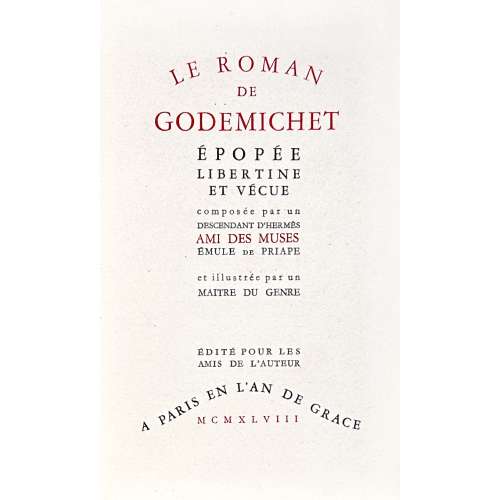 Softcover volume, 23.5 x 15 cm, in tan French flapped wrappers with red lettering to front, collated in-4to, in a tan double slipcase 24 x 15 cm with red lettered label to spine, pp.: [1-12] 13-112 [8], total 120 pages, incl. those within wrappers; printed on thick wove paper watermarked “Lafuma Frères”, 5 full-page and 6 half-page illustrations within collation, incl. frontispiece, guard tissue laid in. Title-page (red and black): LE ROMAN | DE | GODEMICHET | ÉPOPÉE | LIBERTINE | ET VÉCUE | composée par un | DESCENDANT D’HERMES | AMI DES MUSES | ÉMULE DE PRIAPE | et illustrée par un | MAITRE DU GENRE | ÉDITÉ POUR LES | AMIS DE L’AUTEUR | A PARIS EN L’AN DE GRACE | MCMXLVIII || Limited edition 200 + XX, this is copy № 175. Catalogue raisonné: Dutel III № 2336. Jean Reschofsky (French, 1905 – 1998) – artist.
Softcover volume, 23.5 x 15 cm, in tan French flapped wrappers with red lettering to front, collated in-4to, in a tan double slipcase 24 x 15 cm with red lettered label to spine, pp.: [1-12] 13-112 [8], total 120 pages, incl. those within wrappers; printed on thick wove paper watermarked “Lafuma Frères”, 5 full-page and 6 half-page illustrations within collation, incl. frontispiece, guard tissue laid in. Title-page (red and black): LE ROMAN | DE | GODEMICHET | ÉPOPÉE | LIBERTINE | ET VÉCUE | composée par un | DESCENDANT D’HERMES | AMI DES MUSES | ÉMULE DE PRIAPE | et illustrée par un | MAITRE DU GENRE | ÉDITÉ POUR LES | AMIS DE L’AUTEUR | A PARIS EN L’AN DE GRACE | MCMXLVIII || Limited edition 200 + XX, this is copy № 175. Catalogue raisonné: Dutel III № 2336. Jean Reschofsky (French, 1905 – 1998) – artist.


